Sticky slow roast pork belly (made by the Snook), with charred Brussels sprouts and mash (made by me). 😍
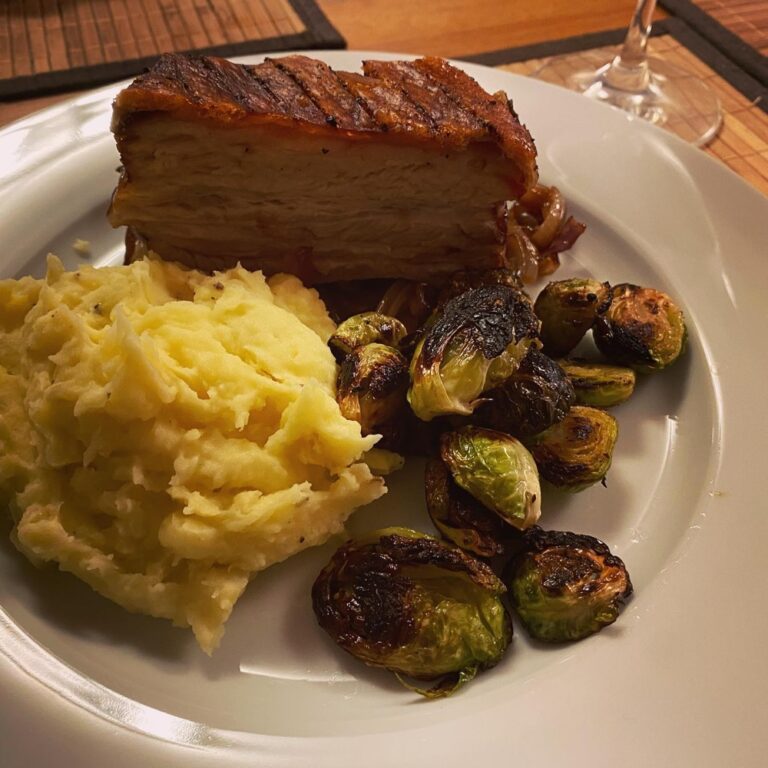
Sticky slow roast pork belly (made by the Snook), with charred Brussels sprouts and mash (made by me). 😍

Halal Street Cart Chicken, made by me!
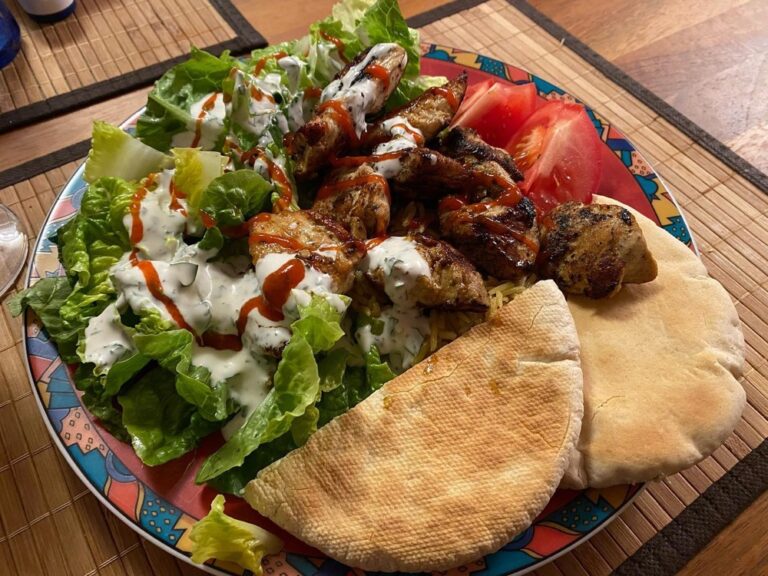
He’s still sick, but we’re still eating well. Chicken Saag curry helps clear out the sinuses… 😍
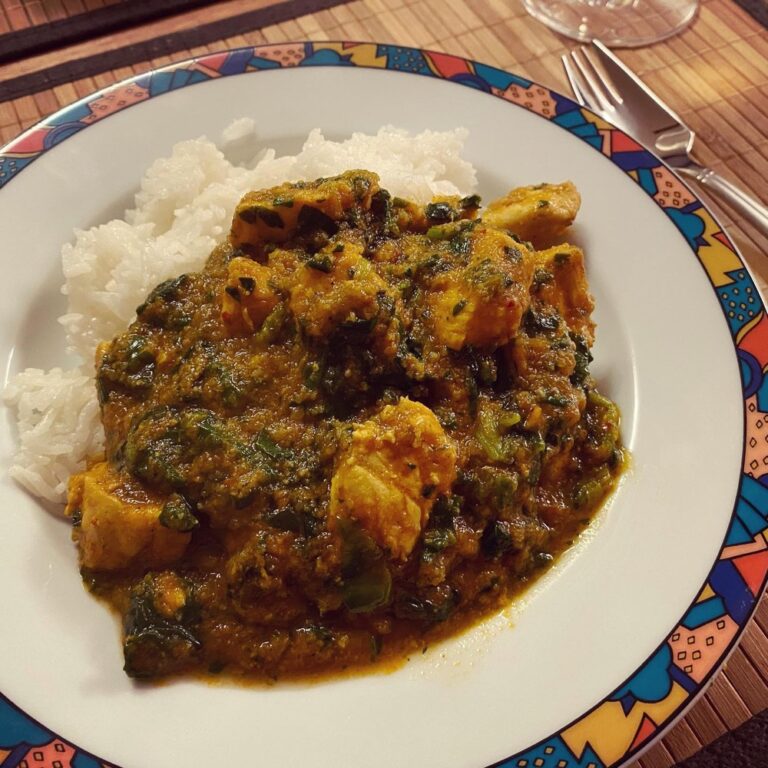
If he cooks like this when he’s sick, can you imagine what it’s like when he’s at full health? 😍🍕
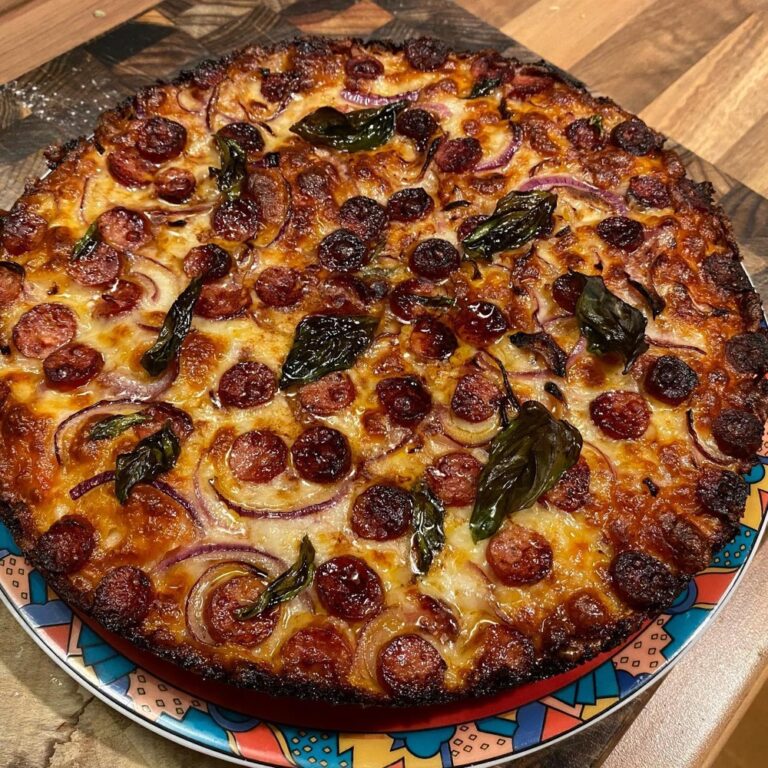
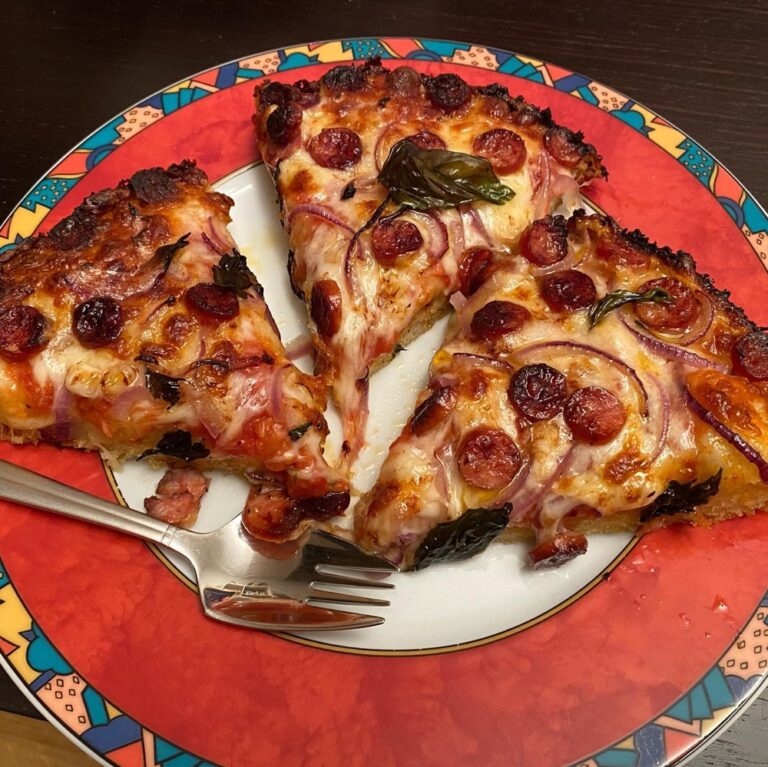
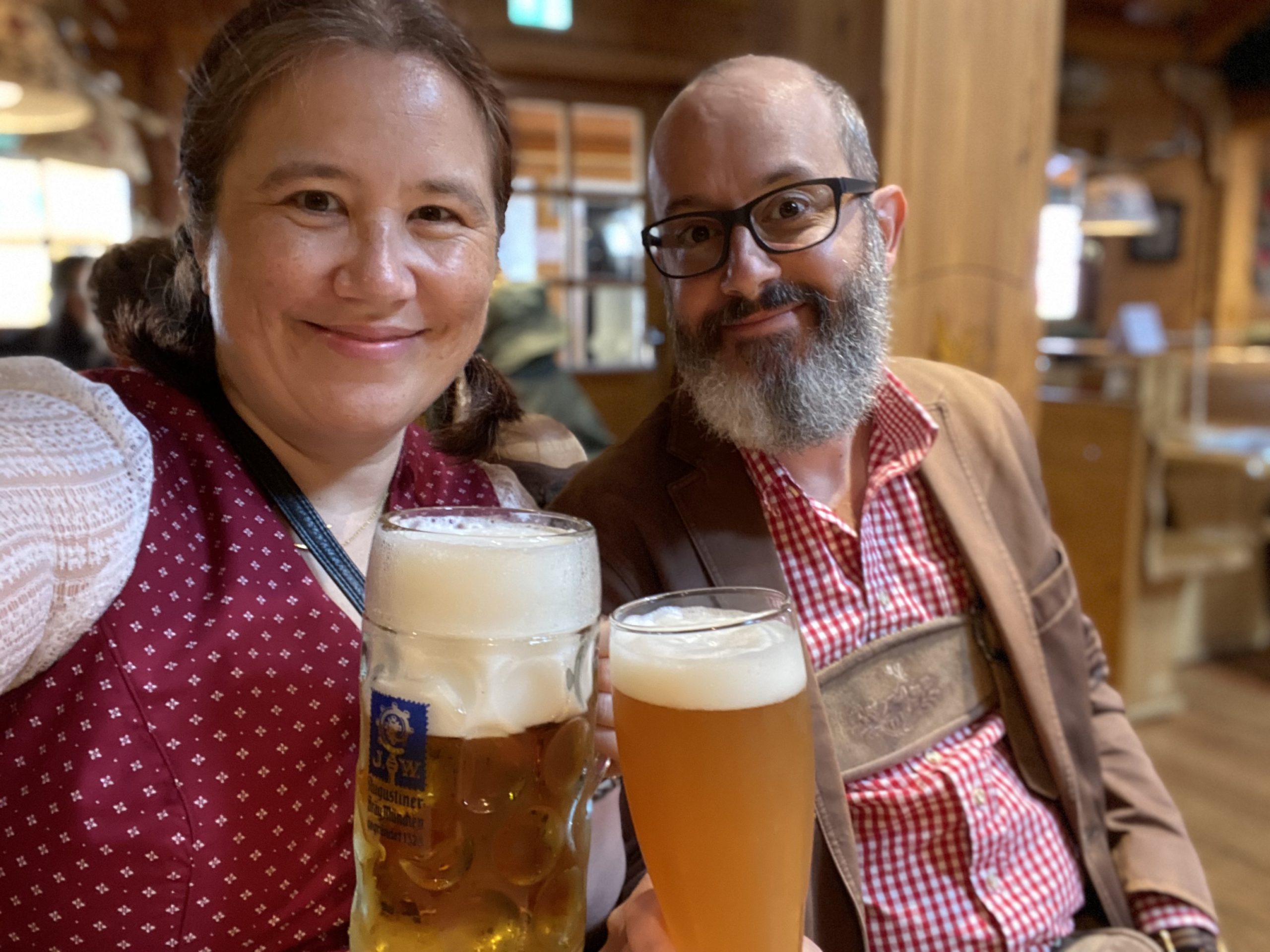
When we got our apartment in Munich, one of the features we were most excited about was its proximity to the Theresienwiese. (We were literally a 5 minute walk to the Bavaria statue.) The Theresienwiese is the big showgrounds (historically it was a meadow) where Oktoberfest happens every year… except, of course, it didn’t happen in 2020 or 2021 because of Covid. This was a major blow to the city, both in terms of the economy and civic pride.
People, there was no way I was leaving Munich without getting to experience Oktoberfest. After our small taste at Frühlingfest in April 2022, we were so excited for it to finally happen in September. Strap in – this is going to be a long post with a lot of photos and videos!
One thing that surprised me was how early they started setting up. In May I was riding my bike across the Wiese and saw the new Pschorr Bräurosl starting to take shape. We found out later that this was because it was a new, larger design than it had been previously, and they needed to set up early so it could go through security tests and approvals.
It also doesn’t look like much of a tent, does it? They’re more like barns than tents.
By the start of July, the rest of the tents were going up as well. The Pschorr Bräurosl now had a roof and the walls were going up. The Schützen Festzelt was also taking shape, as well as the famous Paulaner and Löwenbräu pillars.
A month later in August, things were still further along. I was surprised by the Nymphenburg Sekt tent; I hadn’t realised there were tents for drinks other than beer. (“Sekt” is sparkling wine.)
The last thing to go up were the fair rides in early September. By this point most of the Wiese had been fenced off as the final touches were put in place.
And then I had to head off to Bangkok for a work trip… I landed back in Munich on the morning of Saturday, September 17 – the very first day of Oktoberfest. I caught the train home from the airport and was delighted to see loads of folks in Tracht on the train and in the stations. Many of them were carrying large boards, which I later found out were the trays serving staff use to carry food.
A few hours later I was at home when a large BOOM rattled the house. I realised it was the traditional 12 o’clock opening gun salute and ran to the window to get a video.
We didn’t plan on going to Oktoberfest on the first day, instead frantically cleaning the house ahead of the arrival of our guests the next. Around 5pm I heard drumming and watched as a drum corps marched past behind the house in the pouring rain. In full lederhosen, no less! That’s dedication.
The next afternoon we headed back to the airport to welcome my mom, step-dad, and brother. Eventually we managed to collect them and get them back onto the train home.
The Garbericks were pretty jet-lagged, but we herded them out of the house and down to the nearby Wirtshaus am Bavariapark for dinner. That’s where Joe discovered a new affinity for Schnitzel. 😃
Me and my gorgeous Mom. ❤️
We dedicated the next day to sightseeing. Our first stop was the Olympia-Schimmhalle so Joey (who swims competitively for Ball State) could get in his workout. Interestingly, they had up a sign that due to the war in Ukraine (and the need for Germany to conserve energy) the temperature in the pool would be cooler than normal. Joey didn’t mind.
We walked them all around the Olympiapark, including stopping by the 1972 Olympic Massacre Memorial. The 50th anniversary had recently been commemorated, so there were wreaths for each of the murdered athletes. It was very moving.
We then went into the city to show them the highlights of the Altstadt. We finally went into the Frauenkirche, the symbol of Munich.
Of course I had to take Mom to a local quilting shop! She bought a fabric panel covered in scenes from Munich.
We walked all over, trying to take advantage of the sunshine to help them get over the jetlag. In the afternoon we stopped for a little rest in the Residenz Hofgarten.
The next day was Tuesday, and it was finally time to head to Oktoberfest! Rodd and I got dressed up in our Tracht, and Mom braided my hair for me. It was cold and rainy so I wore boots and a cardigan with my dirndl.
We headed down early to the nearest entrance at the Bavaria statue. A kind person offered to take a group photo of the five of us! ❤️
It was Joey’s 21st birthday, so we’d all chipped in the day before to gift him an outfit from Trachten Rausch. He got a belted lederhosen with a beautiful collarless shirt and knitted socks.
Mom’s wearing my other dirndl. Don’t we look cute?
Pretty quickly, Joe and Joey decided that they needed appropriately Bavarian hats. We stopped at a stall where a very nice guy helped sort them out.
The day was really cool and damp, and it was constantly threatening to rain. Little did we know it would be like this almost every day for the next two weeks.
We walked up and down the aisles checking out the tents. The Schottenhamel Festzelt is the one where – right as that gun salute had happened on Saturday – the first Oktoberfest keg was tapped by the lord mayor of Munich.
Right after this it started to rain, so we decided to make the Armbrustschützenzelt (“Crossbowman’s tent”) our first stop of the day. It was very pretty with its green and white striped ceiling, and it wasn’t very full yet so we easily got a table. It apparently hosts the German crossbow championship (in a side tent) every year.
It had just gone noon, so it was definitely time to get on the beers. Here you can see Joe and Joey modeling their new hats.
The Garbericks were definitely feeling the Gemütlichkeit.
Never underestimate the ability of a 21-year-old to suck down beer. Joey finished his first liter in under 20 minutes!
We also introduced them to “Ein Prosit,” the short little drinking song you hear every 10-20 minutes at Oktoberfest. Here is me singing it very, very off-key. 😂
I was very proud to have remembered to bring my Deckel, a lid for a beer stein. It’s much more useful in the summertime to keep wasps and bees out of your beer in the biergarten. We got a pair of them engraved a few months earlier.
We were finally at Oktoberfest! It was really happening!!
The rain stopped so we headed back out for more exploration. We saw the Paulaner bierwagen and stopped for photos. The wagon is just for show though; pretty much all the beer at Oktoberfest is served from modern kegs. (The only brewery that still does the wooden ones is Augustiner.)
We were getting a bit peckish so stopped off at Cafe Kaiserschmarrn for cake. This tent is run by Rischart, a famous bakery chain in Munich. It looked like a giant gingerbread house!
The nearby Münchner Knödelei (“Munich Dumping House”) had a very cute photo stand-in that Rodd and I couldn’t resist…
We were getting a bit tired and the Americans all needed a nap, so we headed back to the house to recharge. Along the way we spotted the Löwenbrau bierwagen as well.
After a nap, we headed back in the evening to explore the Oide Wiesn. This is a fenced off area that is meant to be more like the historical Oktoberfest, and you have to pay a couple euros to get in. We went first to the Museum tent, where a traditional band was playing.
I really loved the exhibit of all the old Oktoberfest posters. Those ones from the 60s and 70s were so cool! The 2022 design is also available on a commemorative beer mug, which I bought later that evening.
We also checked out the Historische Kegelbahn (“Historic bowling alley”) with wooden balls and pulley-system for restoring the pins.
Time for another beer tent! We went to the Festzelt Tradition, a 5000-seater in the Oide Wiesn that features traditional brass music and dancing. We got a table and ordered some food for Brotzeit. (You’ll notice that we changed into warmer clothes, because the weather was so chilly and damp.)
In the Oide Wiesn tents, the beers are served out of ceramic beer steins rather than glass, and I believe it all comes from barrels as well.
We were absolutely delighted when a group of folk dancers took over the central stage! This was the highlight of the day, seeing them do the Schuhplattler dancing, stomping and slapping their knees and thighs.
The men were later joined by women, who twirled twirled twirled in their beautiful dirndls.
We left the Oide Wiesn in the evening and headed back out to the midway, doing a final lap to buy souvenirs and check out the modern tents. The Löwenbräu tent looked to be pretty popular! My favourite part is the big animatronic lion over the entrance, who throws back a beer and periodically roars.
There are plenty of smaller tents too. We stopped to get some Käsespätzle at Feisingers Kas und Weinstubn (“Cheese and wine parlour”), which was packed with happy Bavarians singing pop music.
Mom really liked her Käsespätzle!
We couldn’t resist the opportunity to finally see inside the Pschorr Bräurosl, after seeing it being built over so many months.
It was PACKED! Definitely not getting a table in here. So many young people, standing room only, up on their seats dancing to rock music. We did a lap and then got the hell out.
And that was it for our first day at Oktoberfest! Time to go home and sleep it all off….
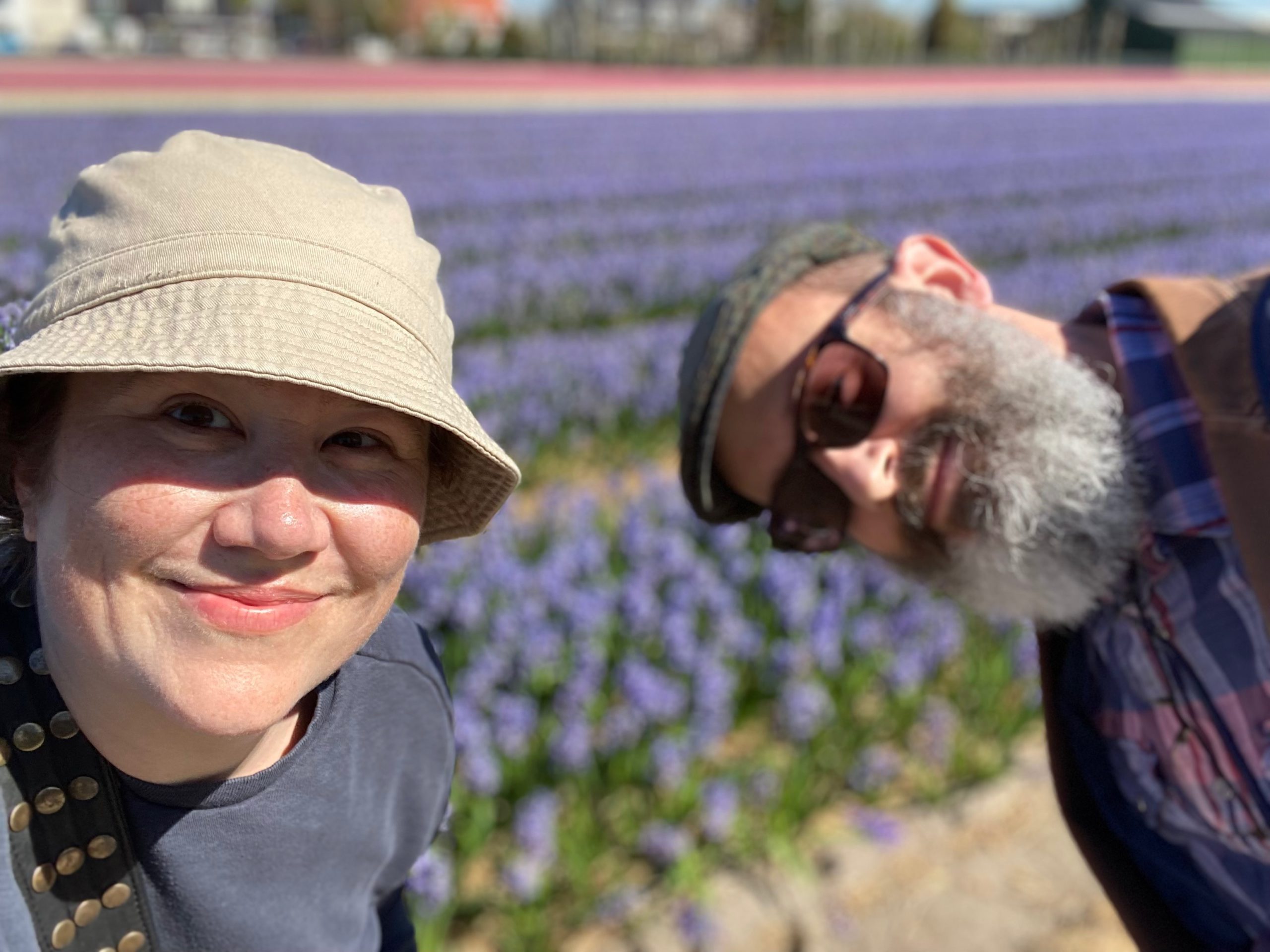
With the four-day Easter weekend looming, we were trying to decide on a city to visit. “There’s a sleeper train to Amsterdam!” the Snook offered. That settled it. Amsterdam had long been on our list of cities to visit (I have a bucket list goal of hitting every one mentioned in Paul Kelly’s ode to Aussies in Europe), and I’ve always wanted to ride in a sleeper train. Time to visit the Netherlands!
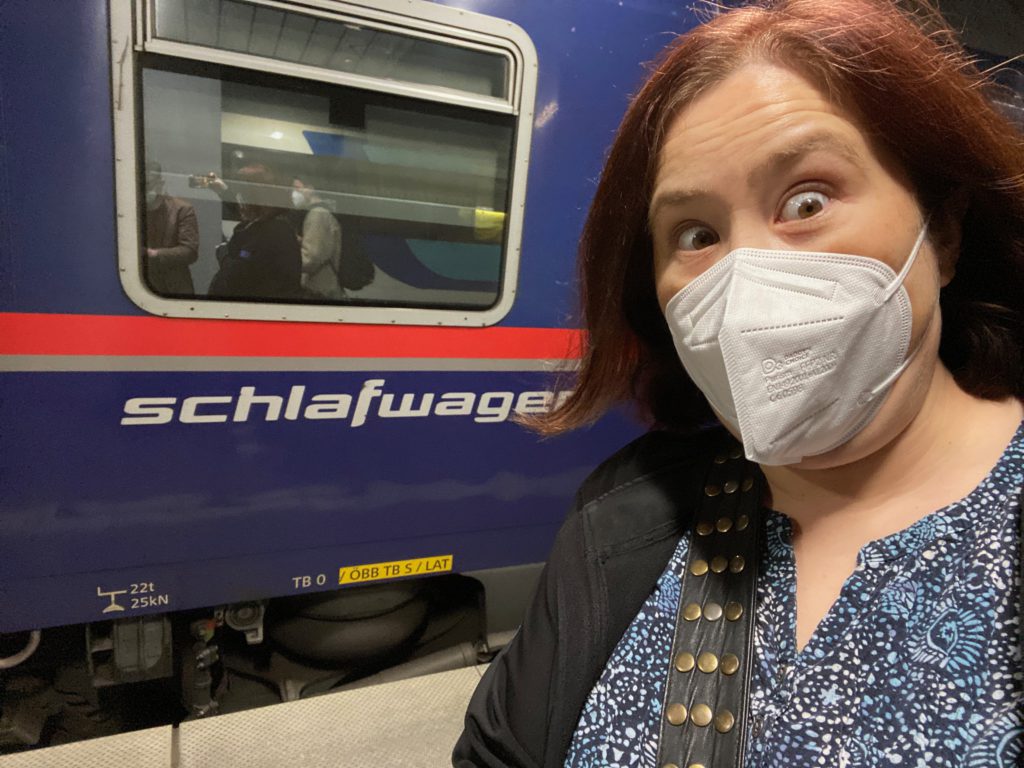
The train – and I am not kidding – is the NightJet NJ420 from Innsbruck to Amsterdam. It has normal carriage cars, and then a couple in the middle that are the sleepers (“Schlafwagens”).
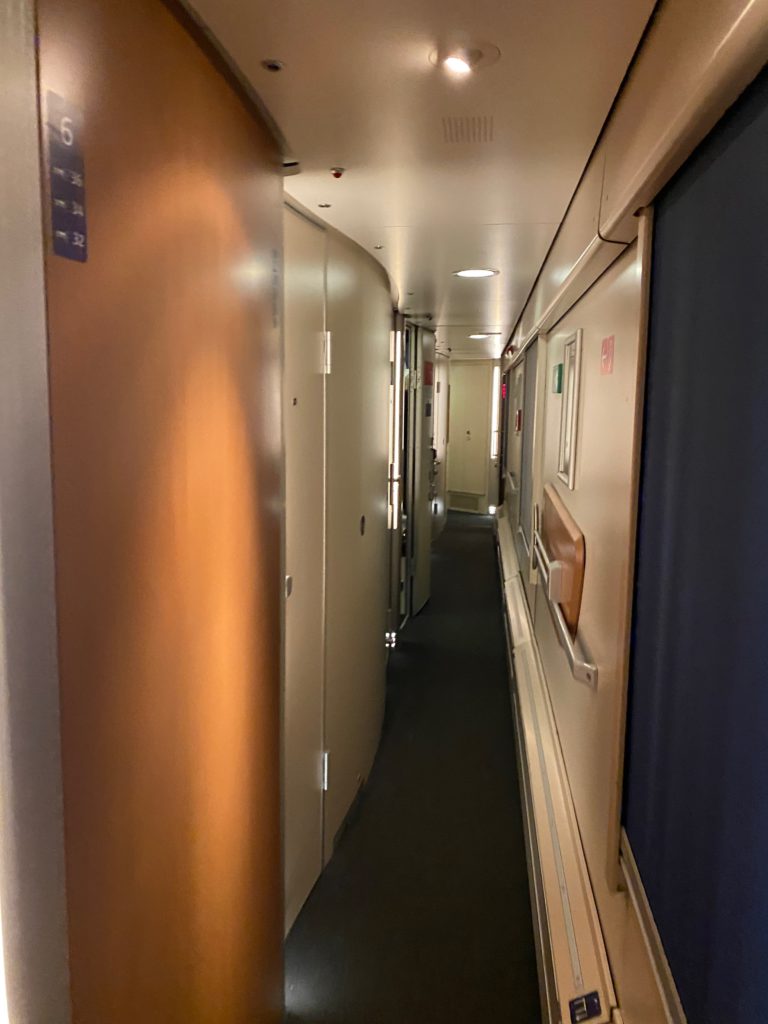
We were greeted by a porter who led us down a very narrow hallway to our cabin.
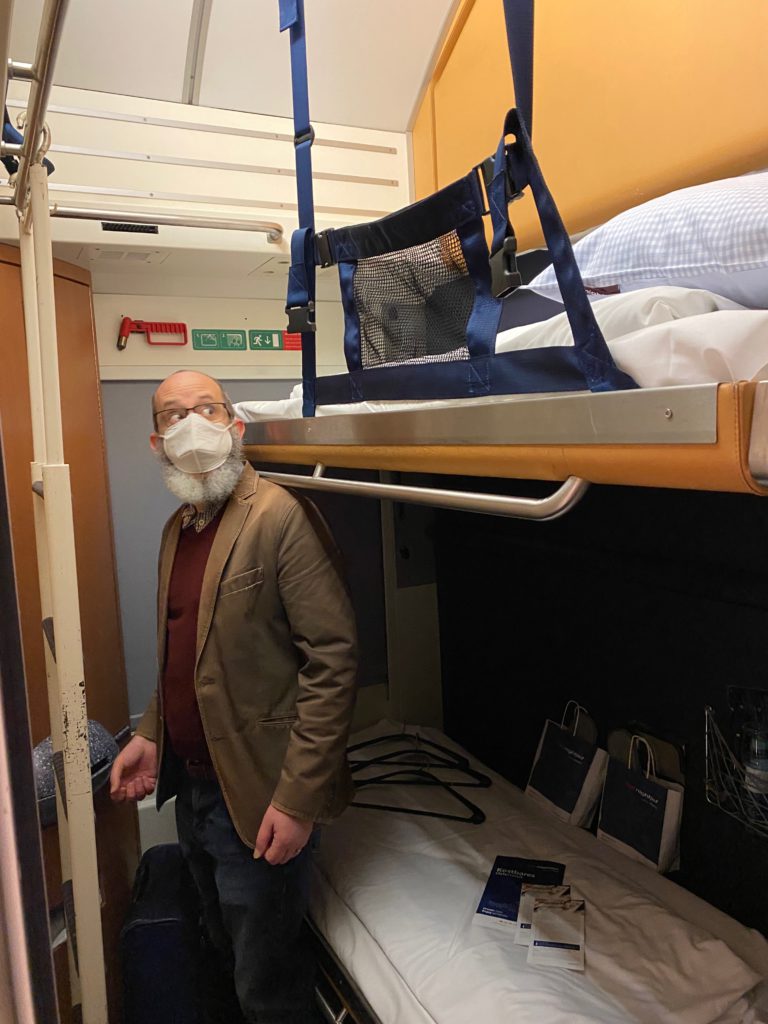
It was about 10:30pm when we boarded the train in Munich, so the porter had already set it up for sleeping. There were two bunks, but theoretically there’s a third one that can fold down if needed.
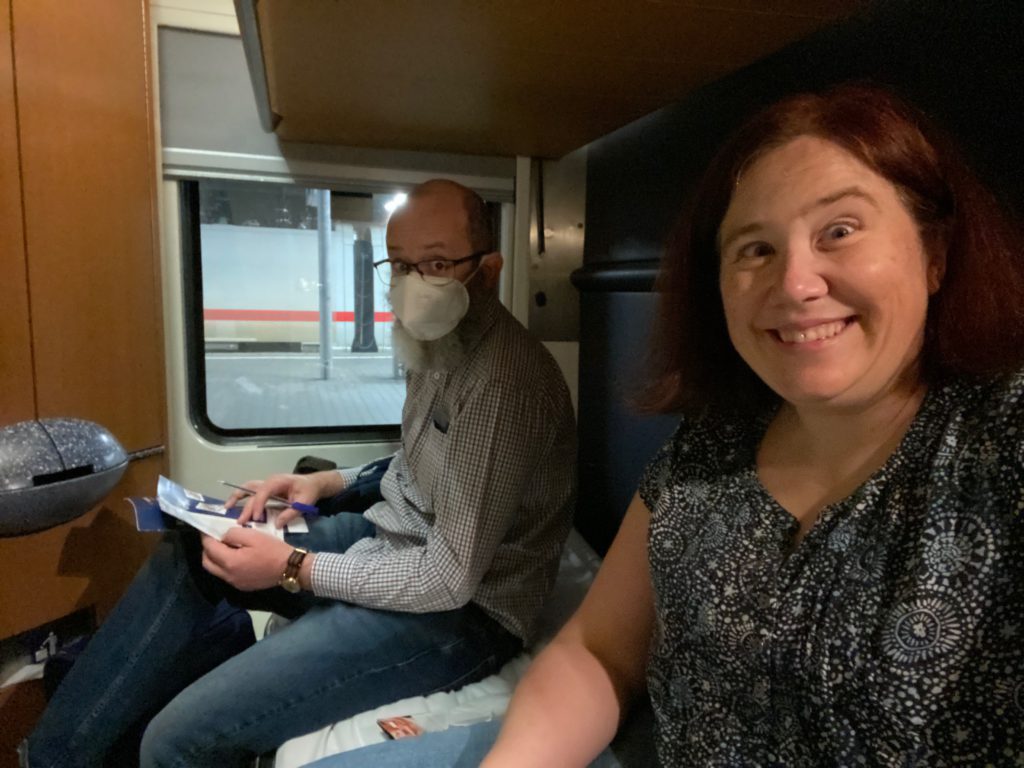
Can you tell how excited I am? The first thing we needed to do was select our options for breakfast in the morning and give the bits of paper to the porter.
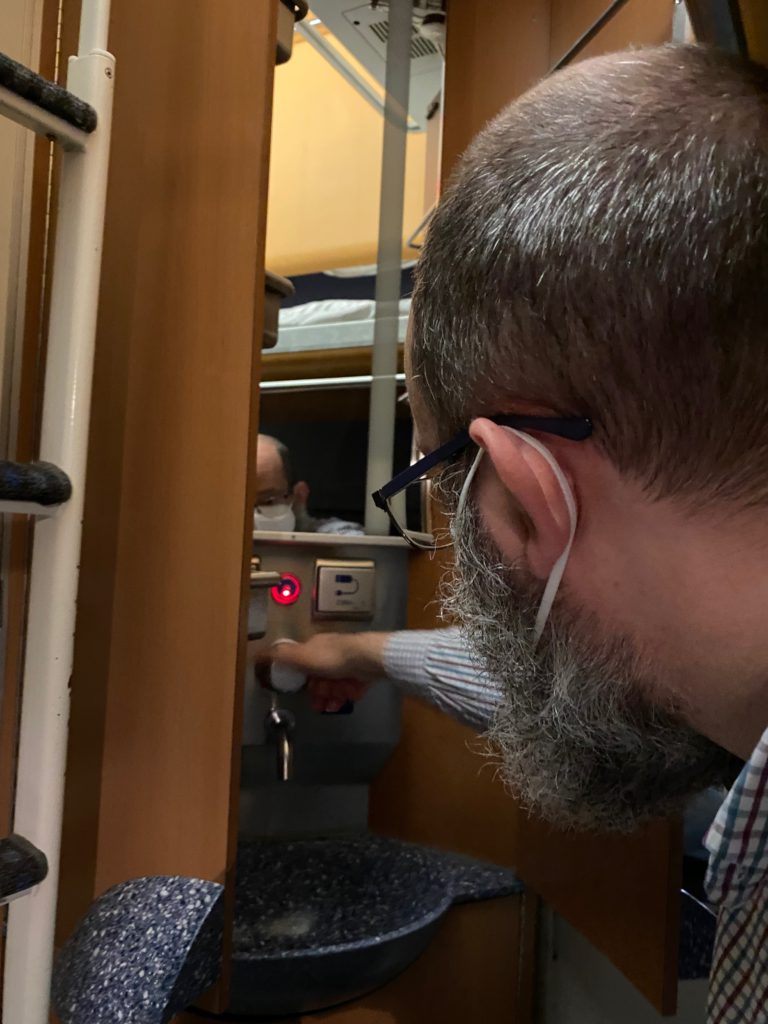
There is a tiny sink crammed into the corner where you could clean your teeth, but the bathroom was a shared one down the carriage. (Unfortunately there was a problem with the water on this journey, so the sink wasn’t working.)
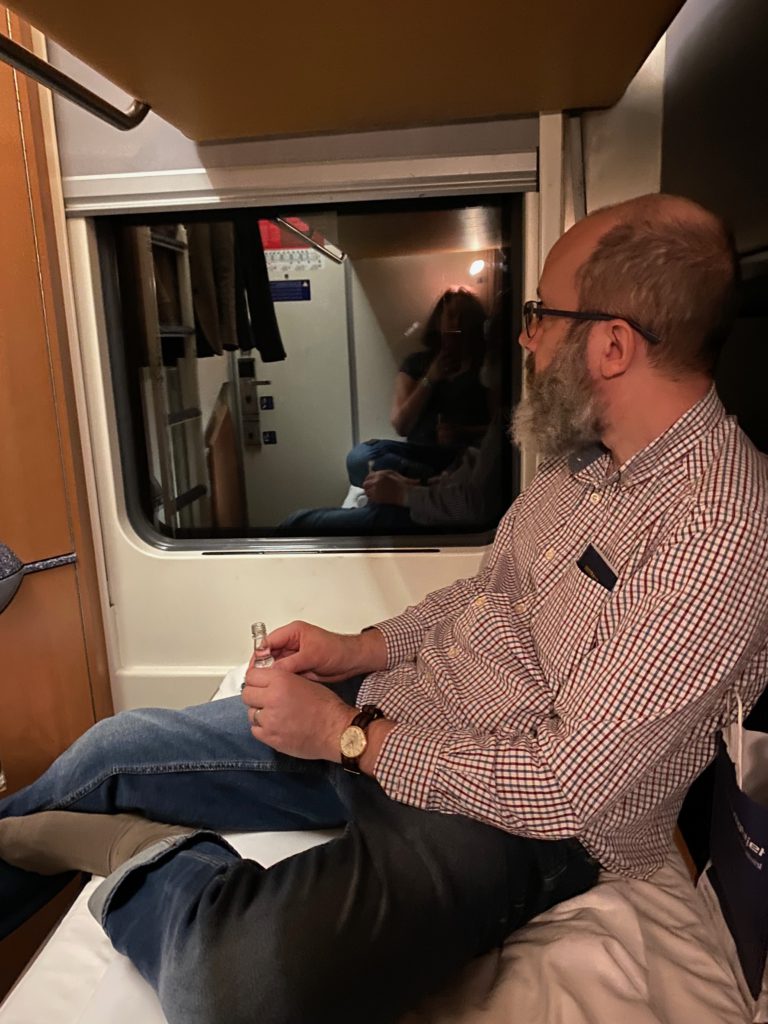
The train pulled out of Munich, and we kicked off our shoes to relax a bit. There was a bag on each bunk with slippers, a bottle of water, a snack, and some sparkling wine. The Snook had also cleverly brought a couple mini bottles of Schnapps…

Prost! We eventually decided it was time to go to sleep. I claimed the bottom bunk so the Snook clambered up the ladder to his berth.

In terms of sleeping comfort, the bunks were just long enough that I could stretch out (I’m 5’10”, 178cm) but anybody taller would be a little cramped. The mattresses weren’t super thick, but for me the bigger issue was the pillows were very, very thin. Still, I did eventually fall asleep. The train does make a few stops during the night and the carriages aren’t soundproof, but I had my headphones playing white noise and it didn’t bother me. The biggest challenge was that since we were lying perpendicular to the train’s movement, whenever it would brake or accelerate you’d feel it. (That’s why the upper bunk has a net, to keep the Snook from rolling right out onto the floor!) Still, the sleeper was nicer than I expected and I definitely got more sleep than I ever have on a long haul flight.

In the morning we opened the window to find ourselves rolling through the Dutch countryside. The porter came by to help us fold up the beds and fold down a table for our breakfast.
We pulled into Amsterdam at 10:30am, blinking in the sunlight and still wearing yesterday’s clothes. Time to find our hotel…

We had left the booking until pretty late so the only place we could get a room was the fancy Marriott W. It wasn’t too far so we had a 15min walk through Amsterdam to get there. It’s actually two buildings across the street from each other, and we were in the “Exchange” building. Reception is up at the roof level, and there’s a pretty spectacular view from the terrace.
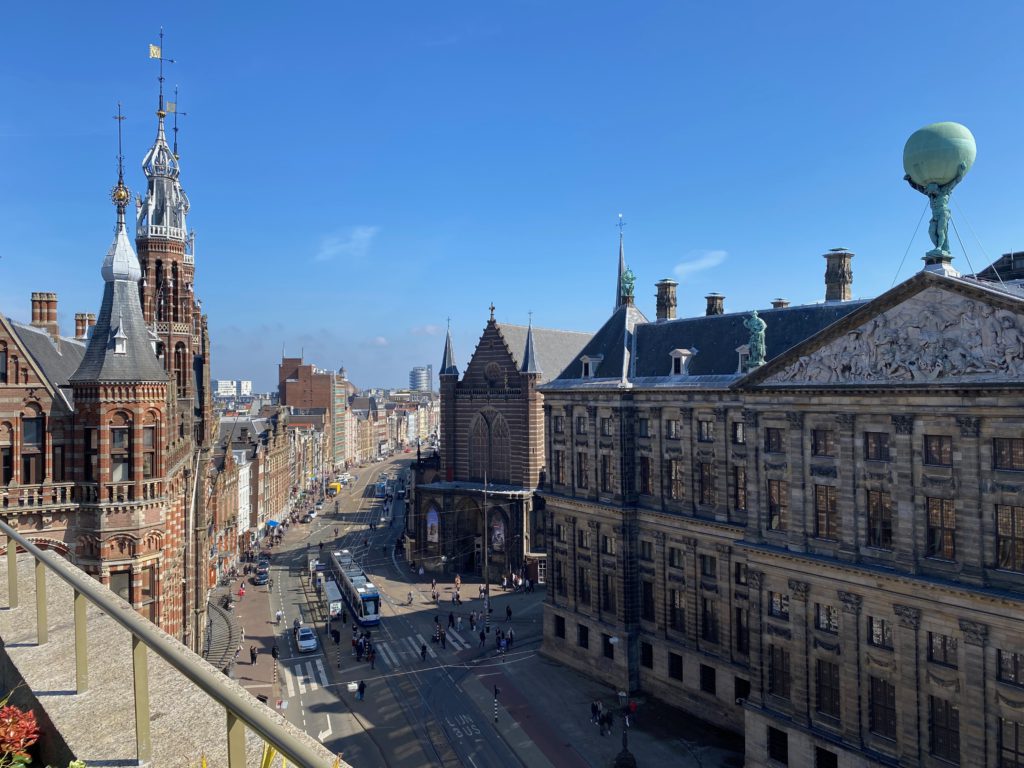
The building on the right there is the Royal Palace of Amsterdam, and the brick one on the left is the Magna Plaza, formerly the main post office of Amsterdam and now a shopping mall.
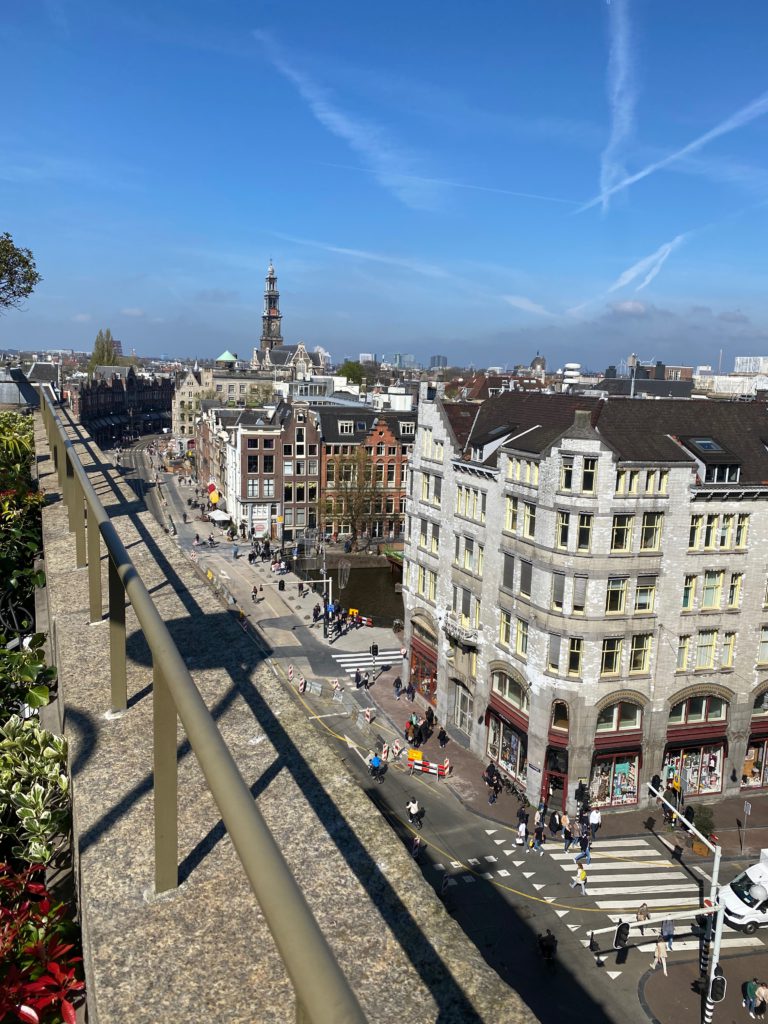
That’s the view up Raadhuisstraat, which crosses several canals. You can see the Westerkerk church spire in the distance.
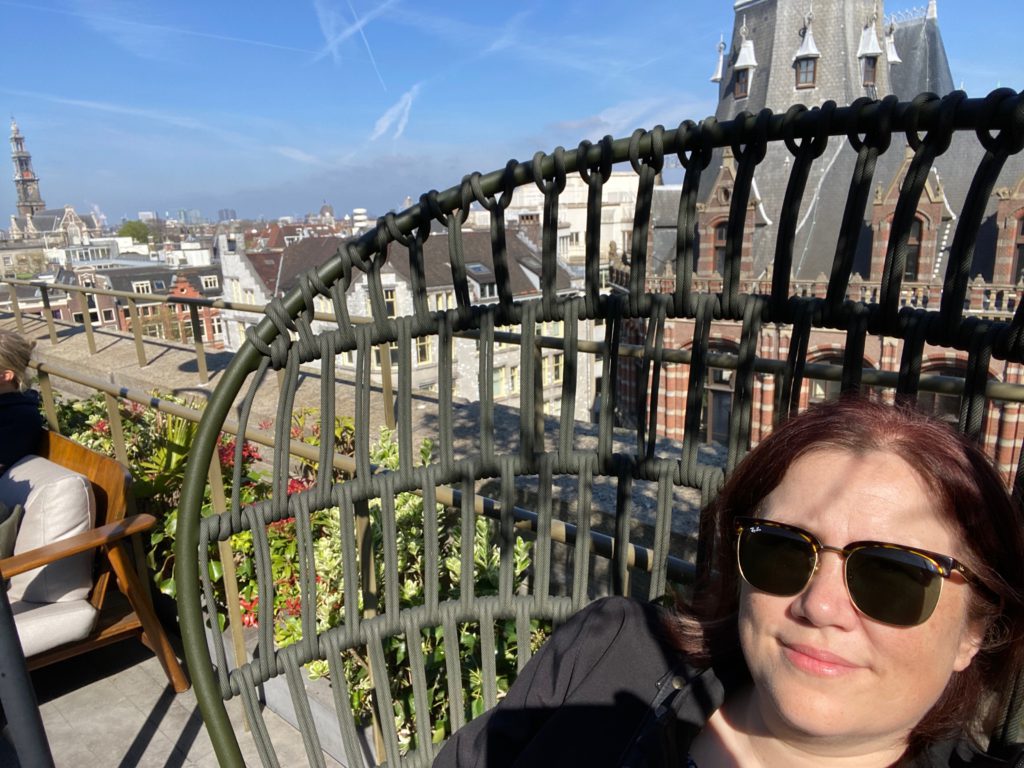
Our room wasn’t ready yet so we made our plans to explore the city. We decided to skip the museums and cannabis cafes on this trip, instead spending as much time as possible outside in the glorious Spring weather.
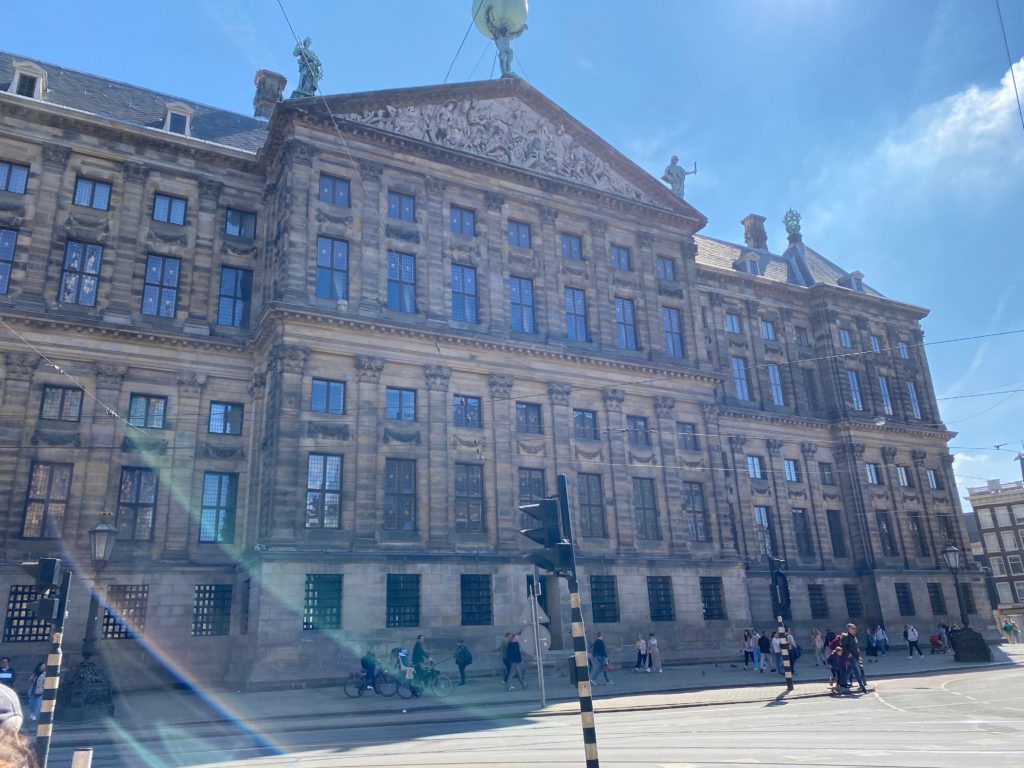
The Royal Palace from ground level. It was originally built as the Town Hall of Amsterdam but was converted into a palace in the 19th century. It’s where Queen Beatrix was announced to the Dutch people in 1980.
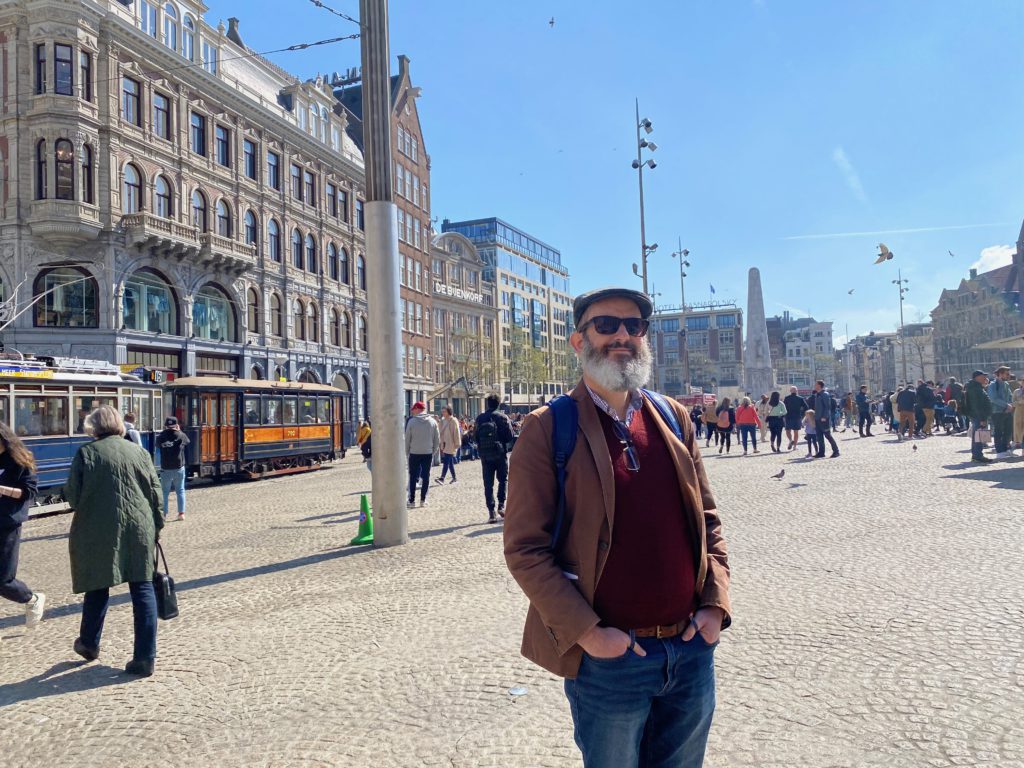
Here’s the Snook in Dam Square, one of the most well-known spots in the city. That’s the National Monument in the distance.
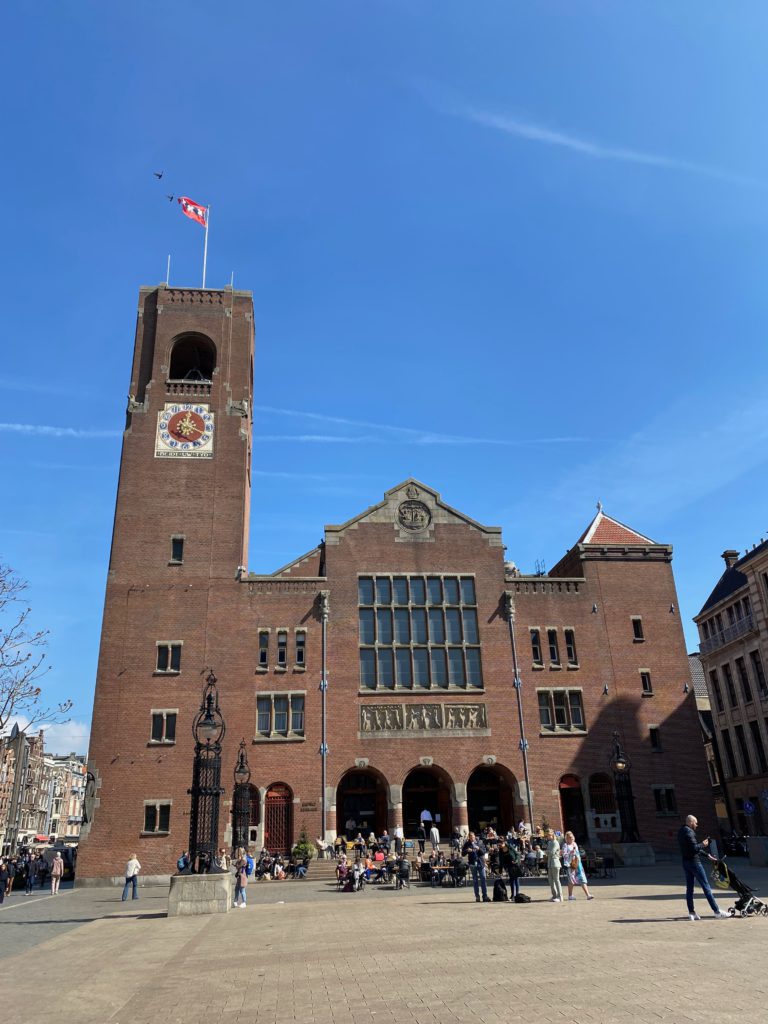
This is the Beurs van Berlage building, which the Snook really liked. I think it was the clock.

This is the Oude Kerk (“Old Church”), Amsterdam’s oldest building. Rembrandt was a frequent visitor to the Oude Kerk and his children were all christened here.
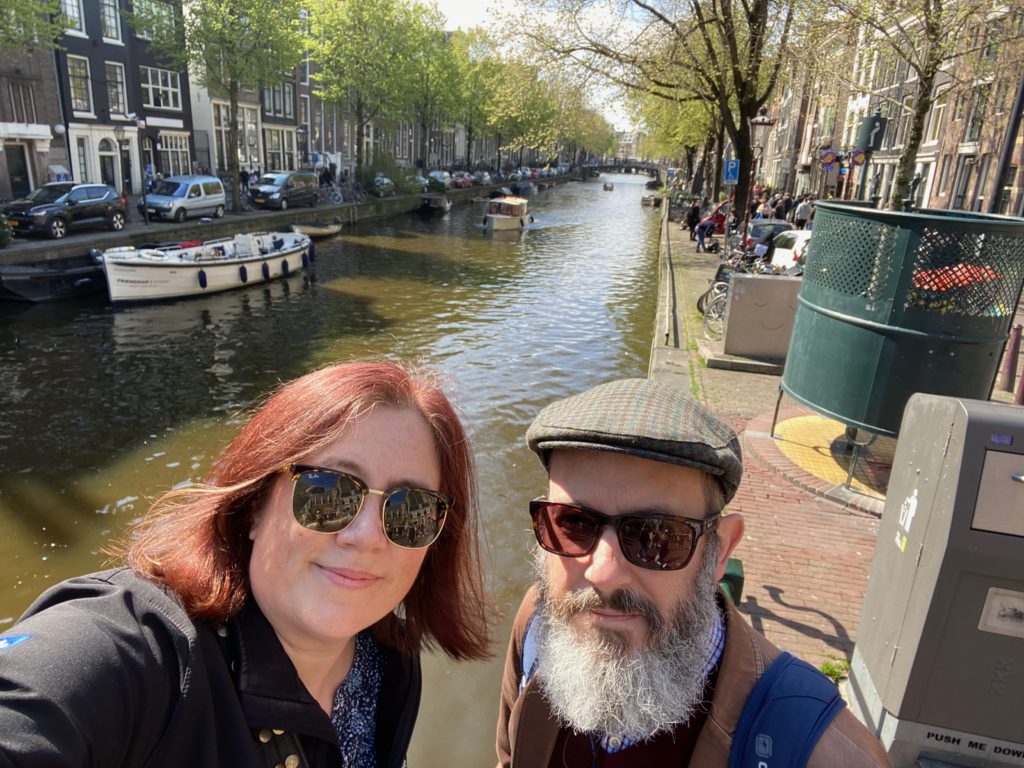
Canal!! This is the view from the Oudekerksbrug (“Old Church Bridge”).
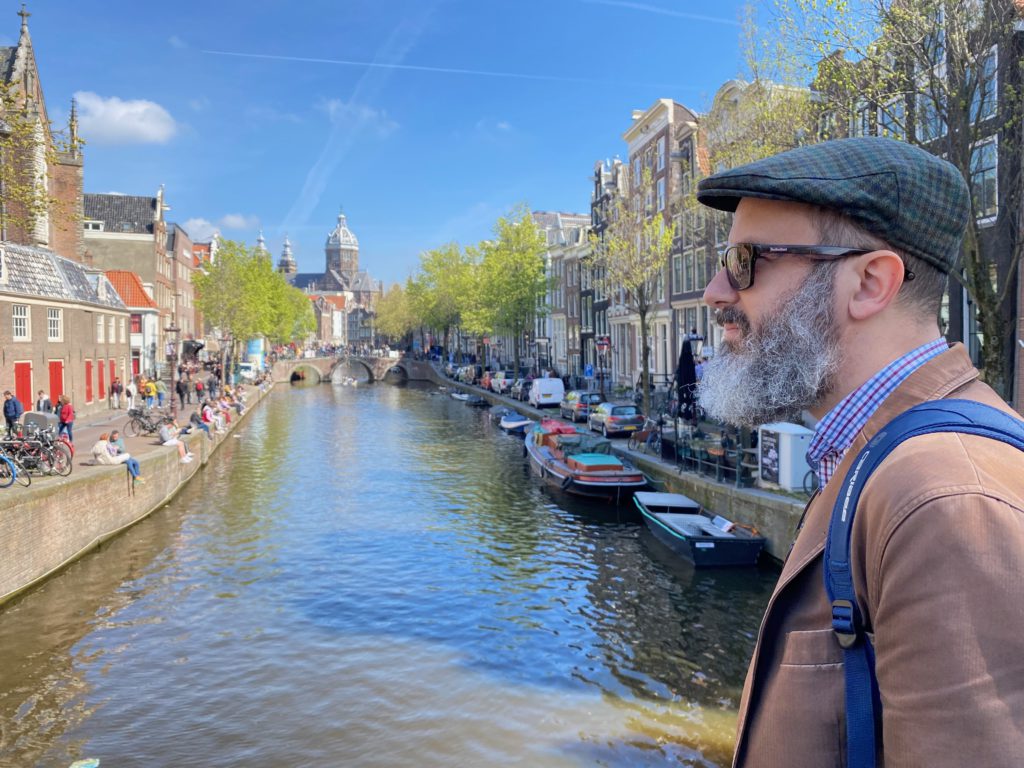
This is looking north towards the Basilica of Saint Nicholas, the city’s primary Catholic Church.

I was entranced by the canals of Amsterdam. There are more than 100km of them (62mi), with 1500 bridges in the city.

You know what else I was entranced by? CHEESE.
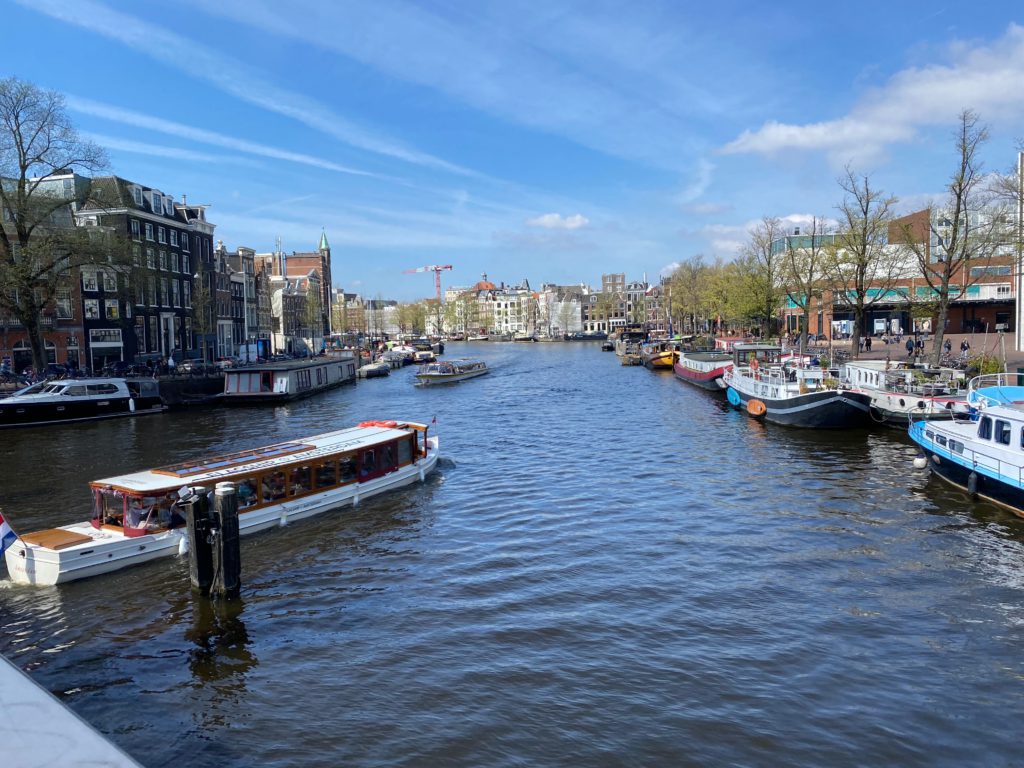
This is actually the Amstel river as seen from the Blauwbrug (“Blue Bridge”). There are a LOT of houseboats in Amsterdam. There were also a lot of river cruises going up and down the river and canals too.
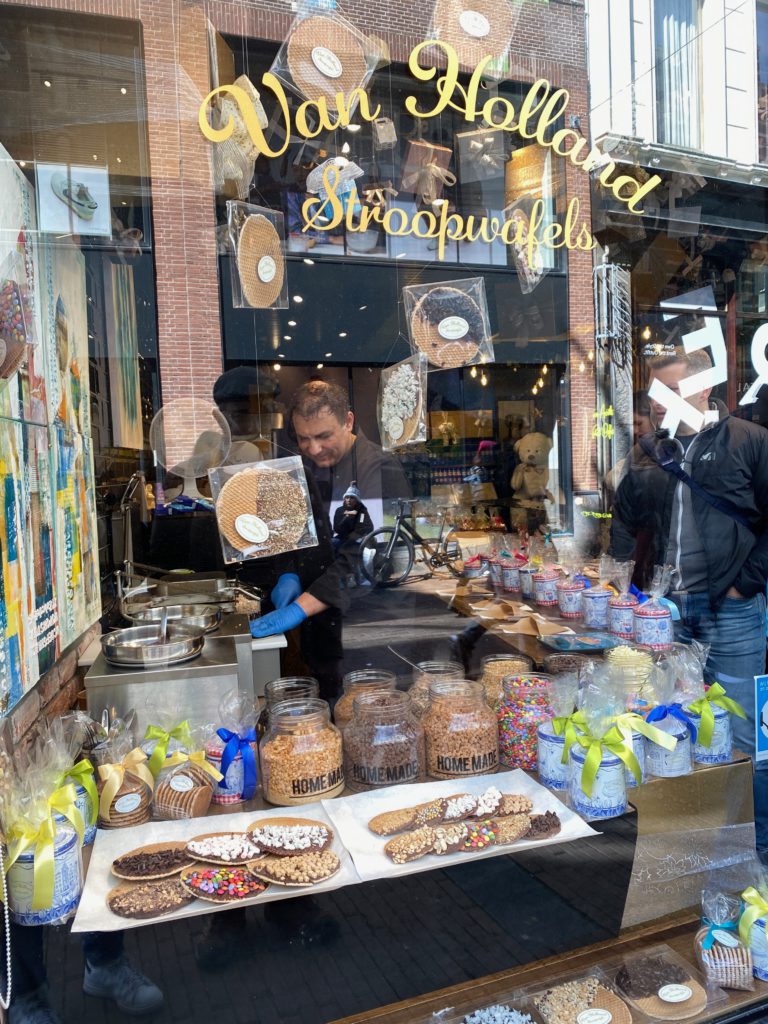
We walked up the Kalverstraat, Amsterdam’s main shopping street. (Fun trivia: it’s the most expensive property on Dutch Monopoly!) There was a queue out the door at Van Holland Stroopwafels, and we made a mental note to come back later for treats.

The LEGO Store had a massive working windmill in the window!
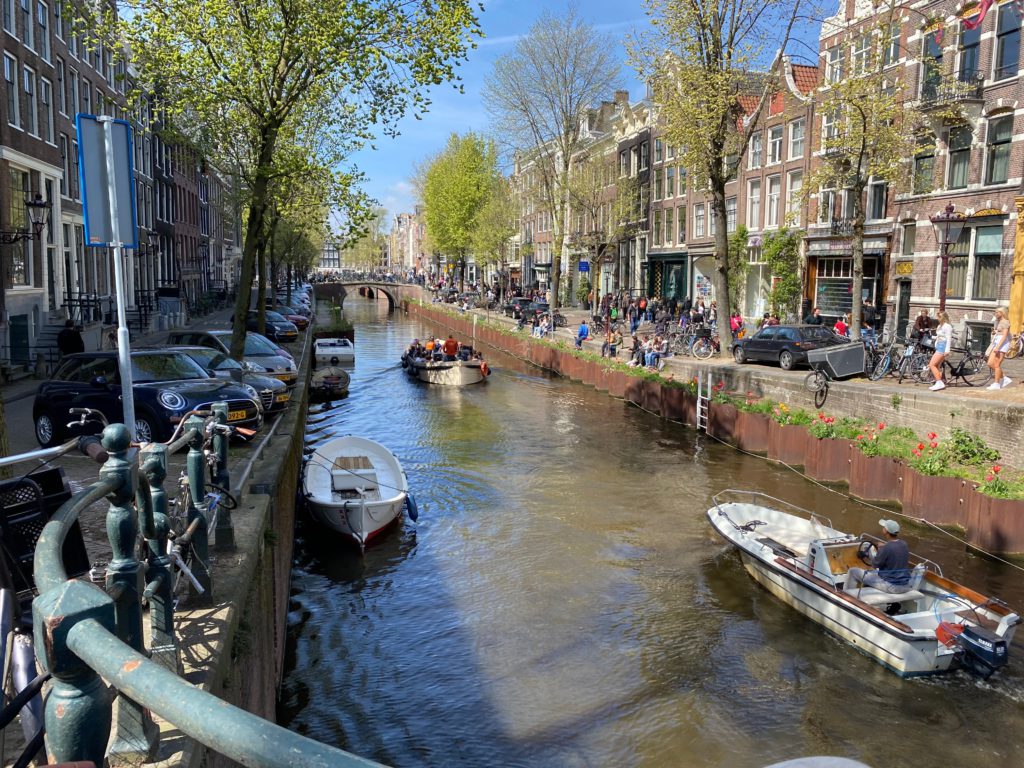
More canal action! Everybody was out enjoying the Easter weekend Spring weather.

Get ready – you’re going to see a lot of tulips! There were blooming planters all over the city.
After lunch, we headed back to our hotel for a nap and shower. Then it was time to go out and meet my Amazonian colleague Anshu!
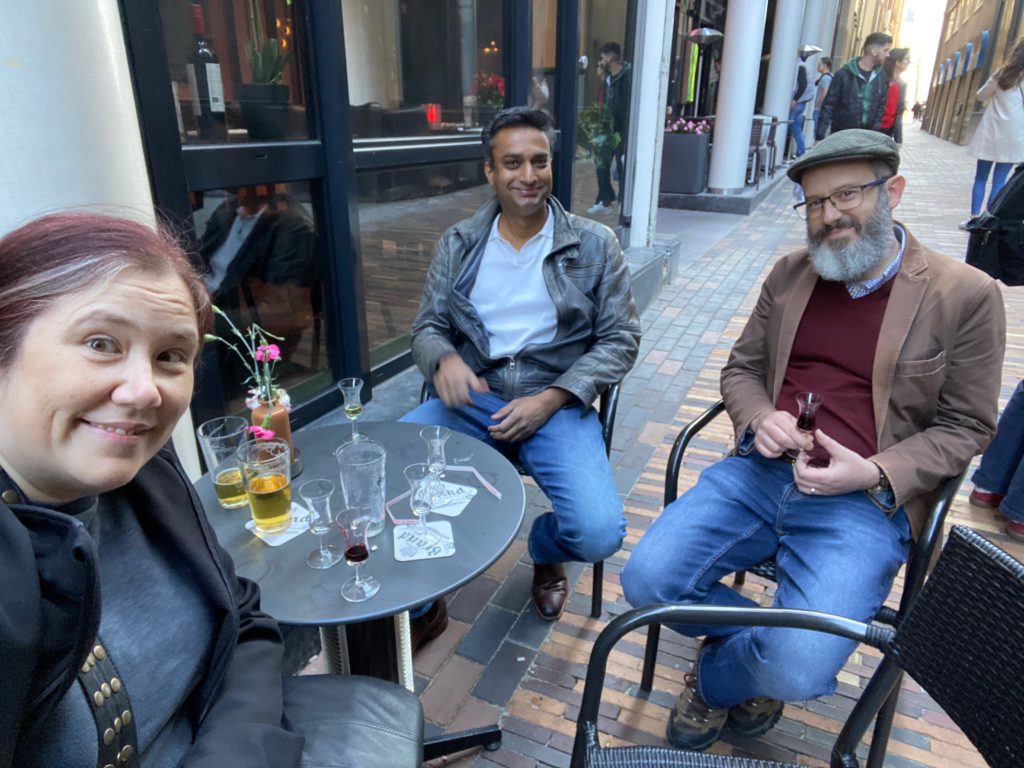
Anshu moved from Melbourne last year, so he volunteered to show us around Amsterdam. The first place he took us was Wynand Fockink, a distillery tasting room straight out of the 17th century.
We stood in the crowd and waited our turn to get to the front. They had more than 50 different liqueurs, including jenever (the Dutch precursor to gin). The attendant explained all about jenever to us and gave us a taste, and then we picked out a couple brandies to try. (I went with cherry; the Snook with sloe.) The tiny glasses are filled right up to the brim, and you’re meant to bow down to slurp the first sip out of them. Fun!

Our next stop was a Dutch craft beer bar called the Arendsnest, along one of the canals. We sat outside and enjoyed some excellent brews as the sun got lower in the sky.
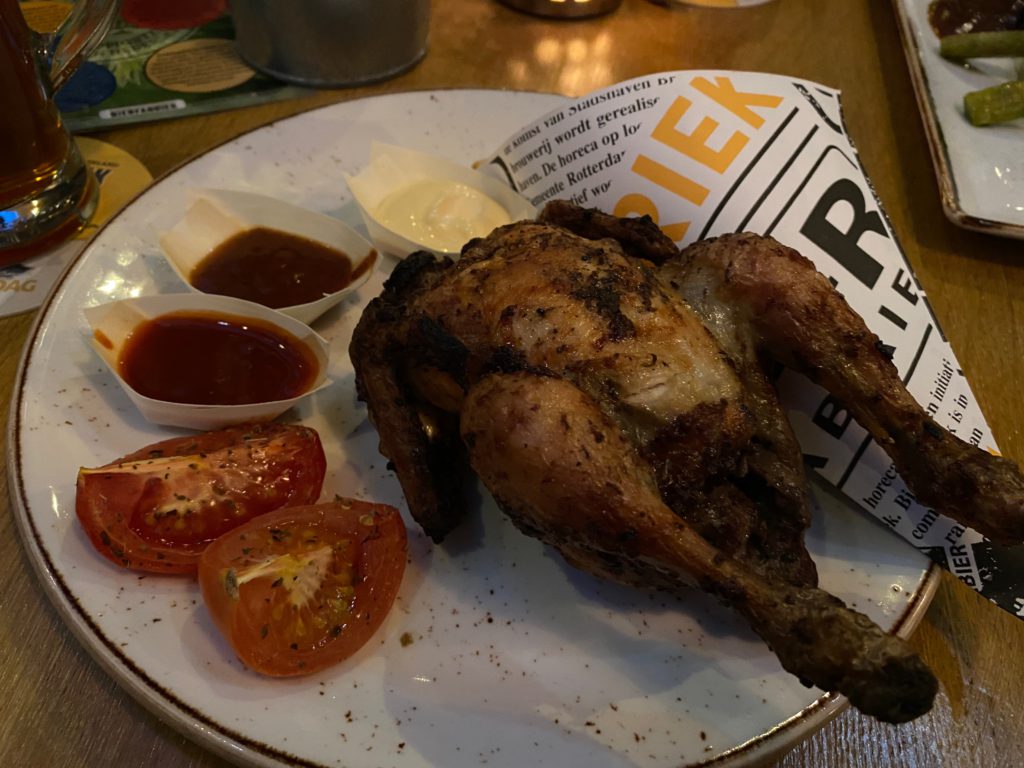
Our final stop of the night was Bierfabriek Amsterdam, a brewery and restaurant right in the city. It was crowded by they found us a table tucked in the corner. Their specialty is “rustic slow roasted French farm chicken,” and who could resist that?
We said our goodbyes to Anshu and headed back to the hotel to rest up ahead of a very big Easter Sunday…
Korean Corn Grilled Cheese, made by the Snook with his own homemade bread. 😍
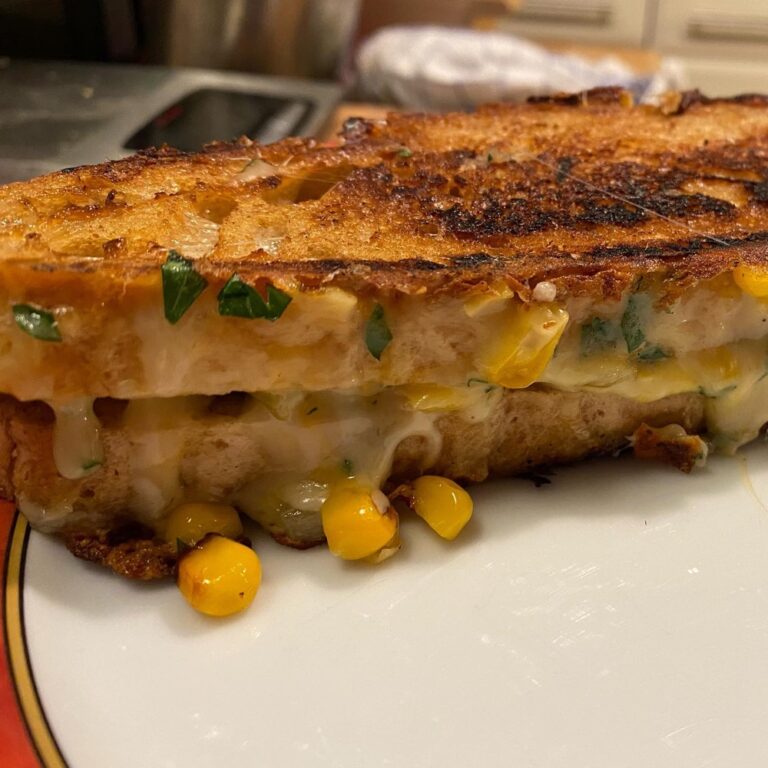
“Ich habe für dich ein lustiges Oster Geschenk” 😍🐇
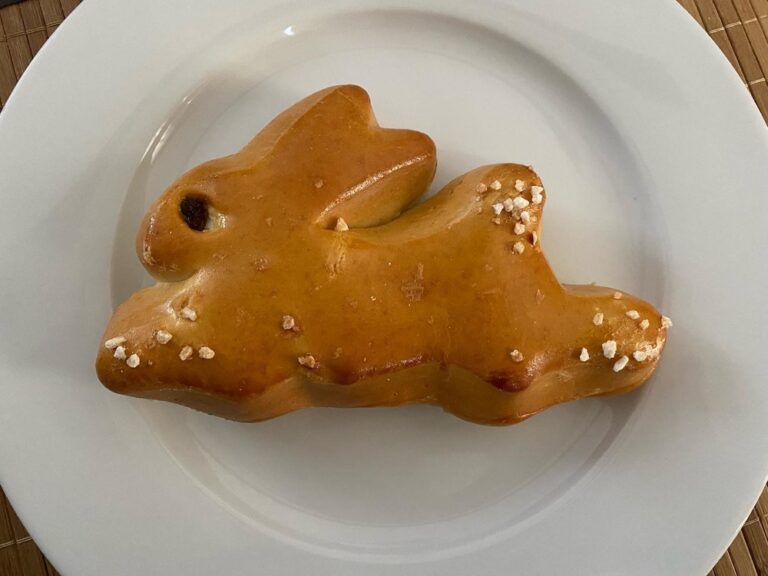
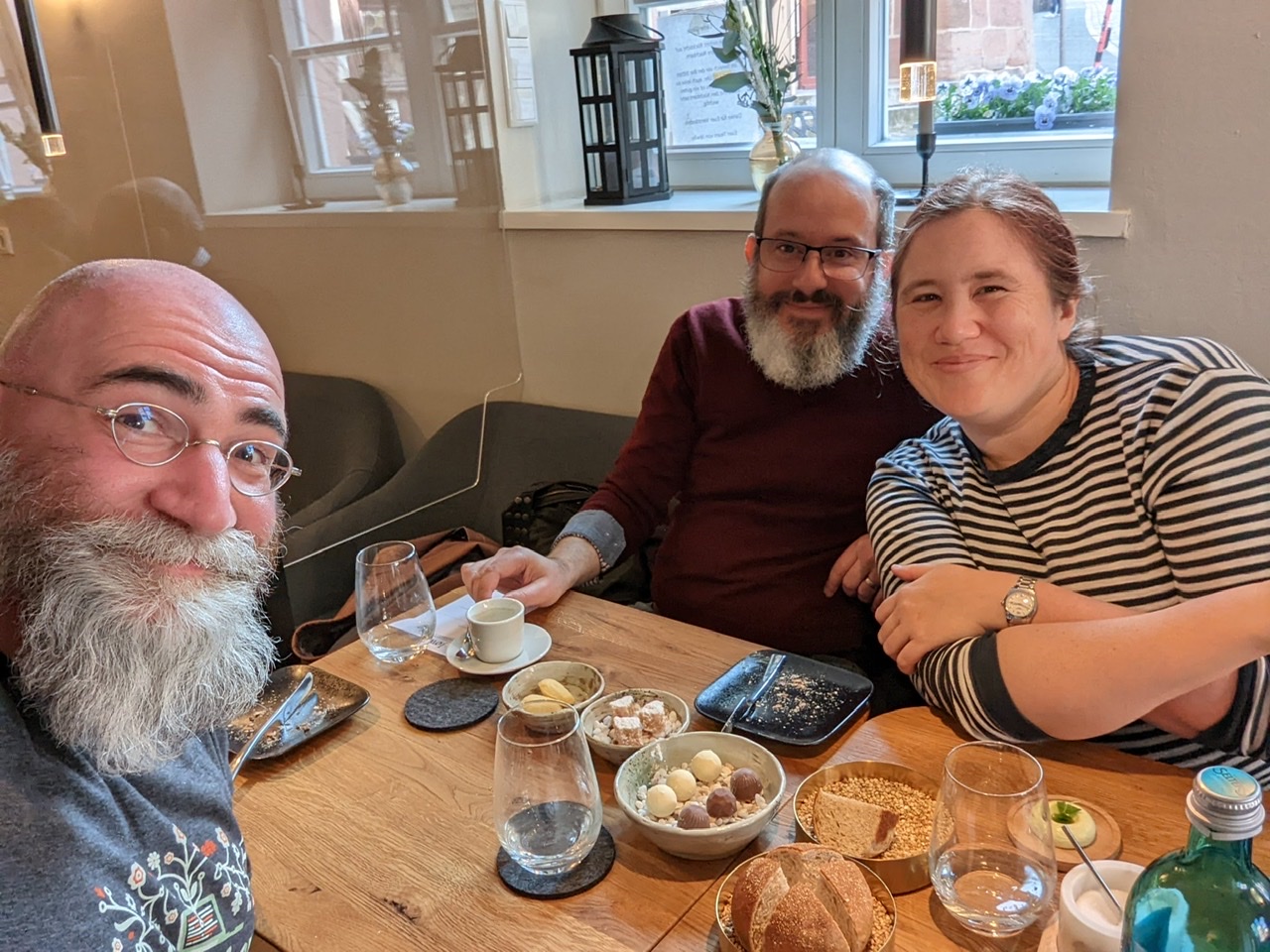
Last year I attended the AWS Nürnberg Meetup Group (via Zoom) and learned a couple things: 1) Nürnberg = Nuremberg, which I had previously naively thought was an entirely separate city 😂; 2) despite being technically located in Bavaria, Nürnbergers do NOT think of themselves as Bavarian but rather Franconian; and 3) the folks there are incredibly friendly. The organiser of the AWS group is Frank, and when I mentioned that I’d like to visit his city someday, he said to let him know and he’d give us a personal tour. But nobody actually means things like that when they say it, right?
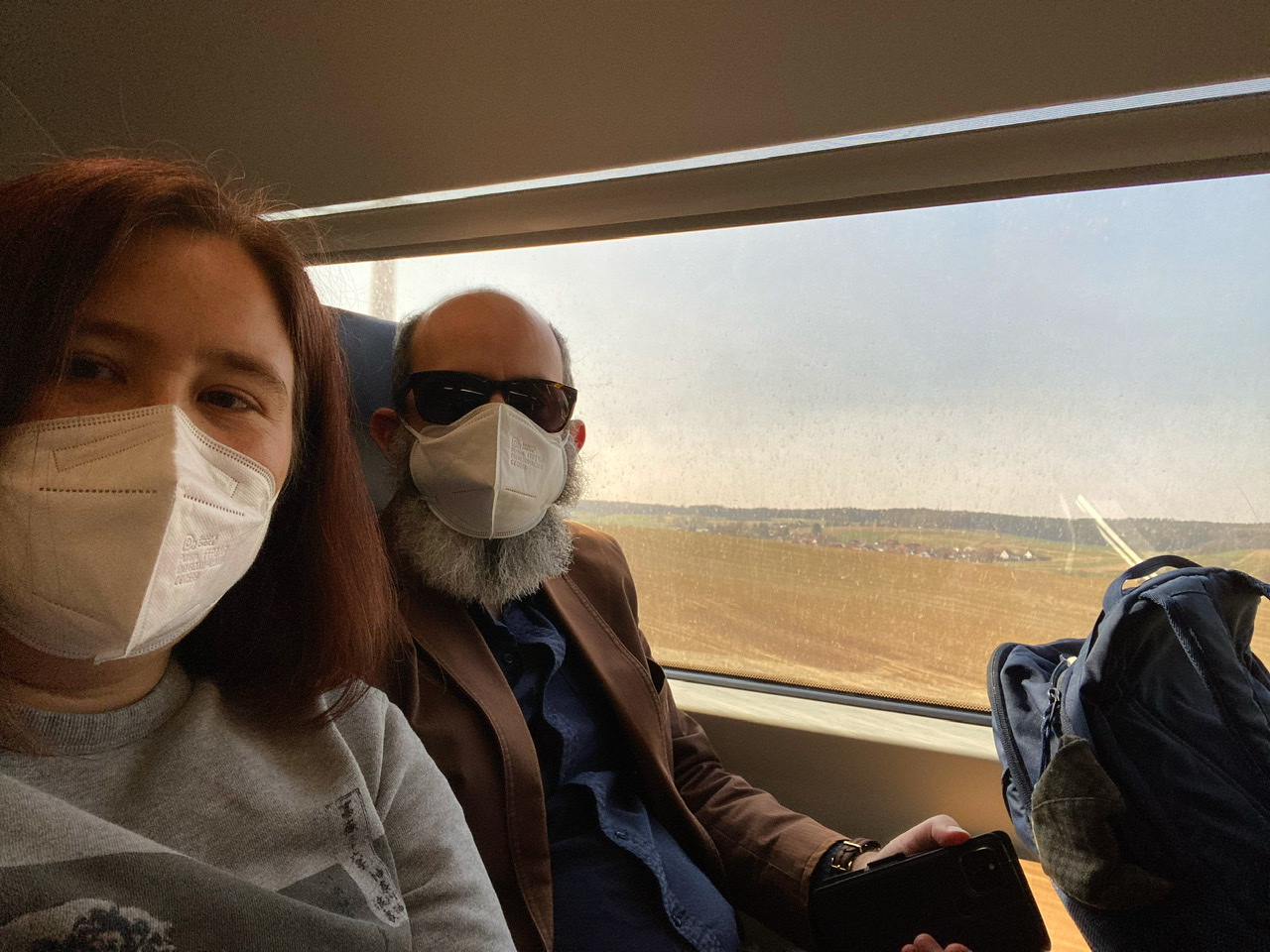
At any rate, two weeks after we got home from Vienna we boarded a Friday evening train to Nürnberg. It’s a very fast trip from Munich (less than 90min) so we were there well before the sun set.
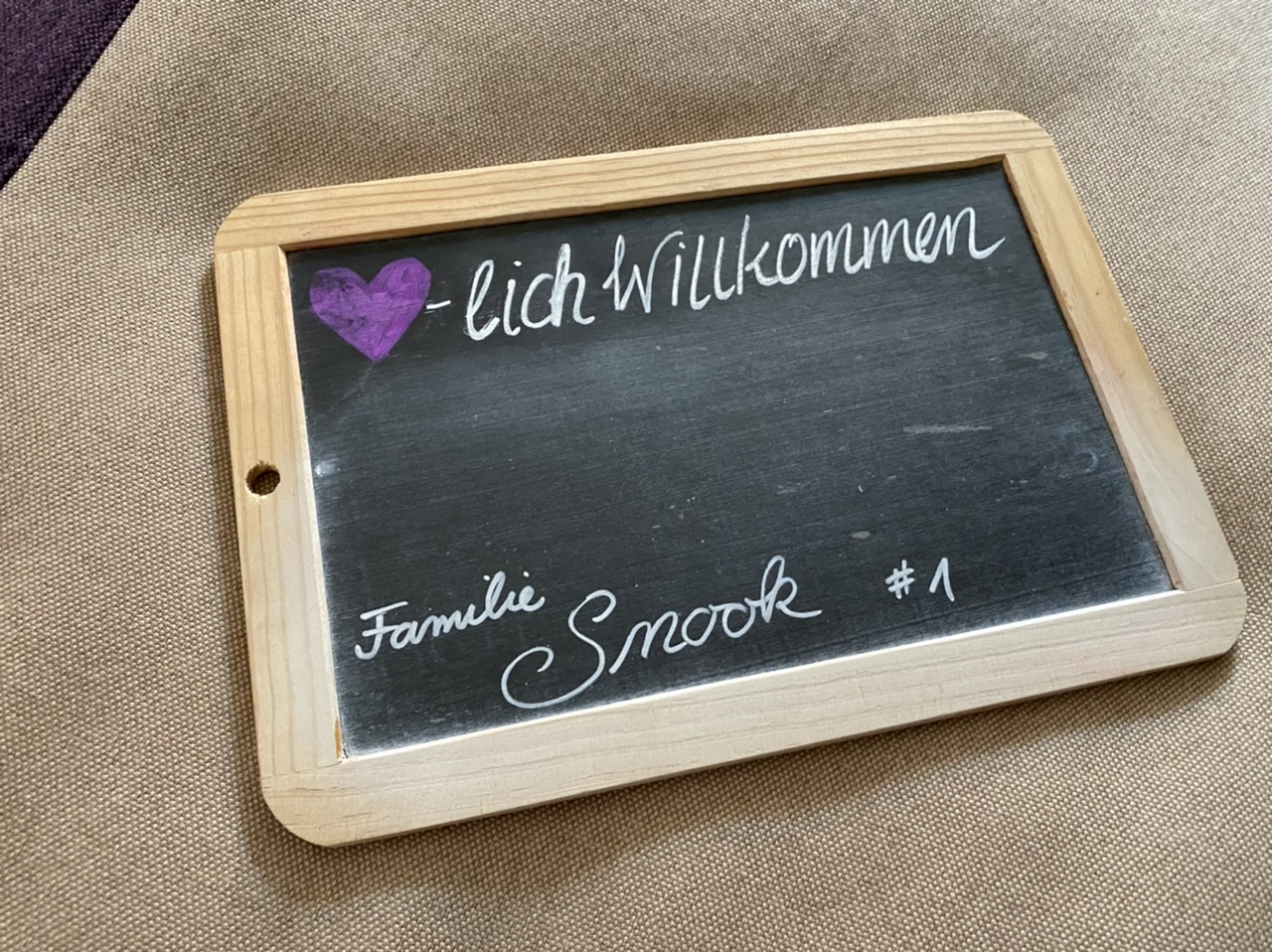
Um, how cute is that? We had booked a room at Hotel Elch (Elk), which looked to be pretty centrally located to everything we wanted to see. Our room was on the very top floor, right underneath the roof, and without an elevator it was a decent hike up maybe 4 flights of stairs. That’s what you get when you stay in a heritage building.
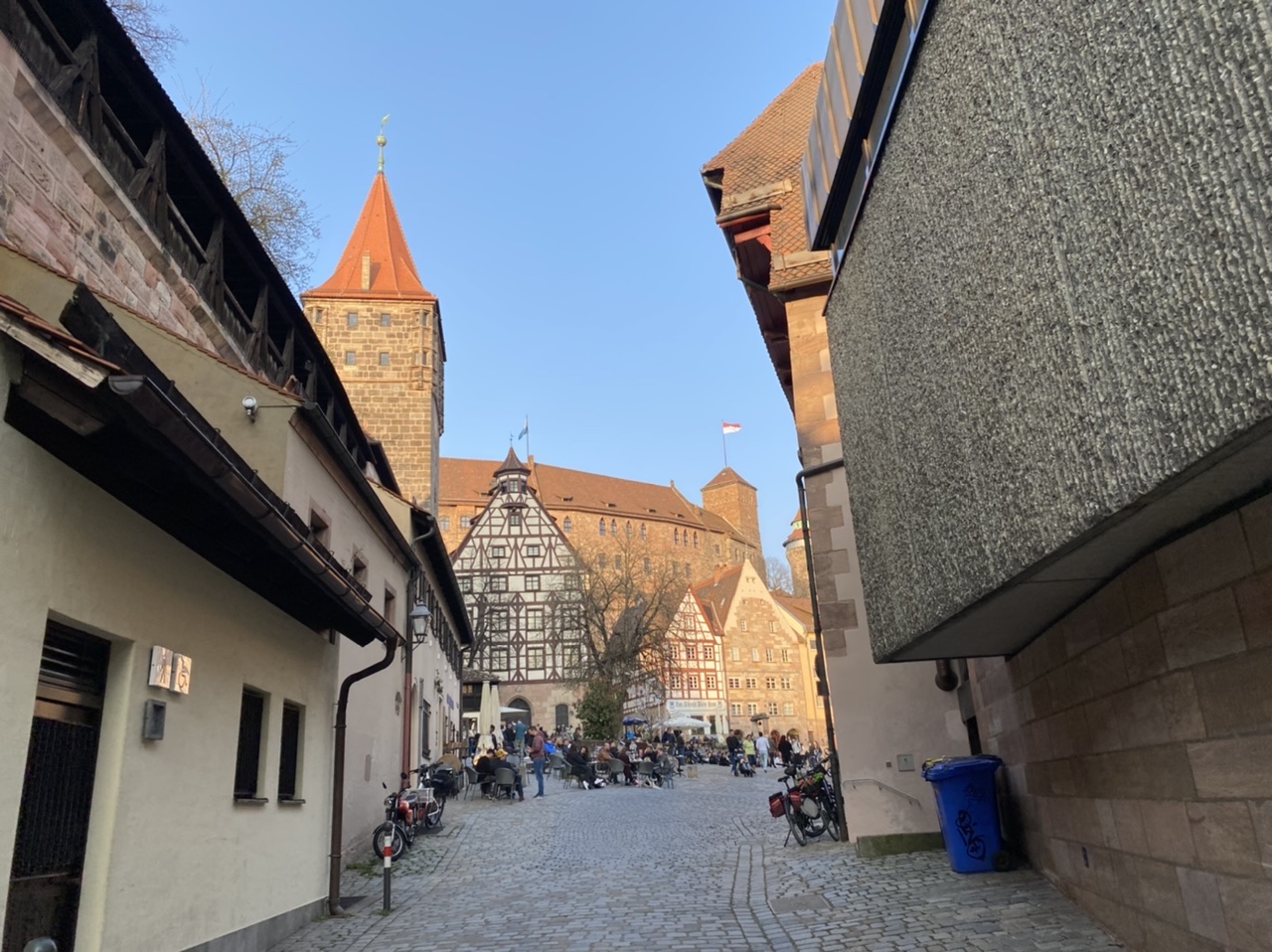
Frank had given us a tip to make sure to come on a weekend with nice weather. We’d timed it well and the forecast was nothing but blue skies. We dropped our stuff and went for a wander. The center of Nürnberg feels very medieval with its cobbled streets, city walls, and castle looming up on the ridge. Our first destination was the Hausbrauerei Altstadthof, which is the starting point of the Historische Felsengänge tour.
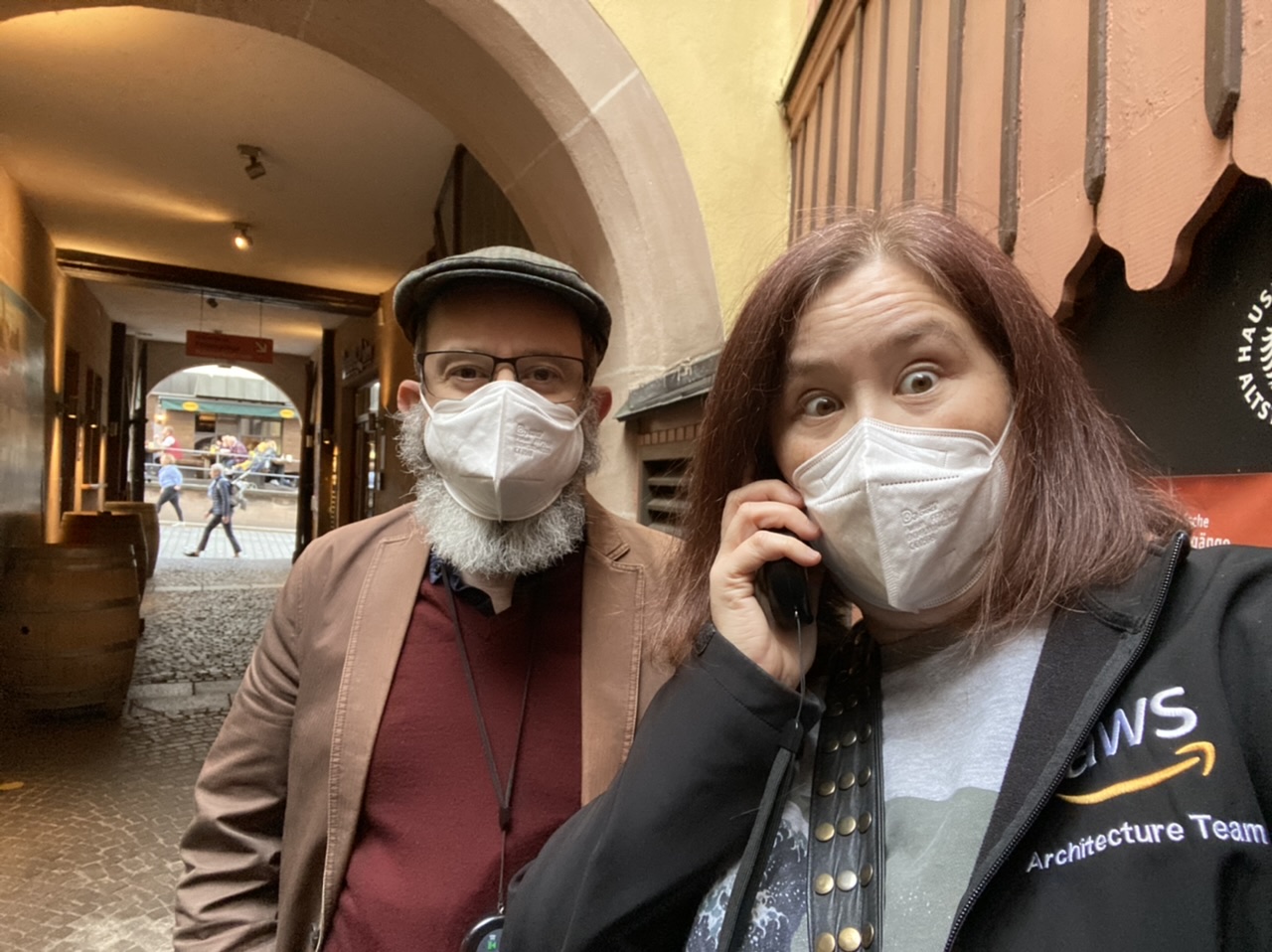
There were only a few of us on the tour. The guide was a friendly older local guy who spoke only German, so the Snook and I were offered electronic devices where we could punch in numbers at each stop and hear an explanation in English.
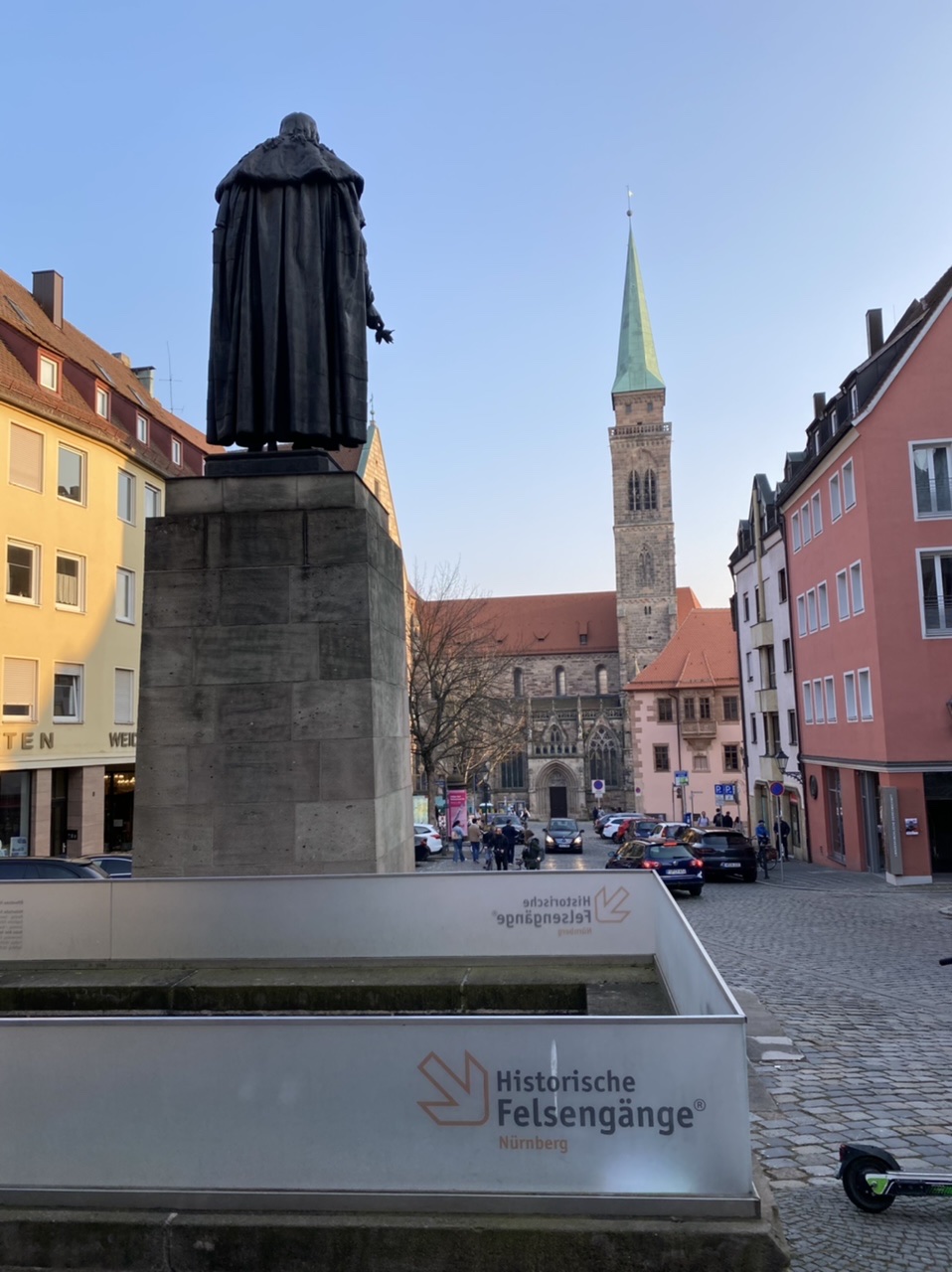
Felsengänge means “rock passages” and refers to the extensive system of tunnels and cellars carved into the rock beneath Nürnberg. While there are many access points around the city, the main tourist entrance is in Albrecht-Dürer-Platz, right next to the statue of the famous local artist and facing St. Sebaldus Church. We went down the stairs and our guide unlocked the heavy door and ushered us inside.
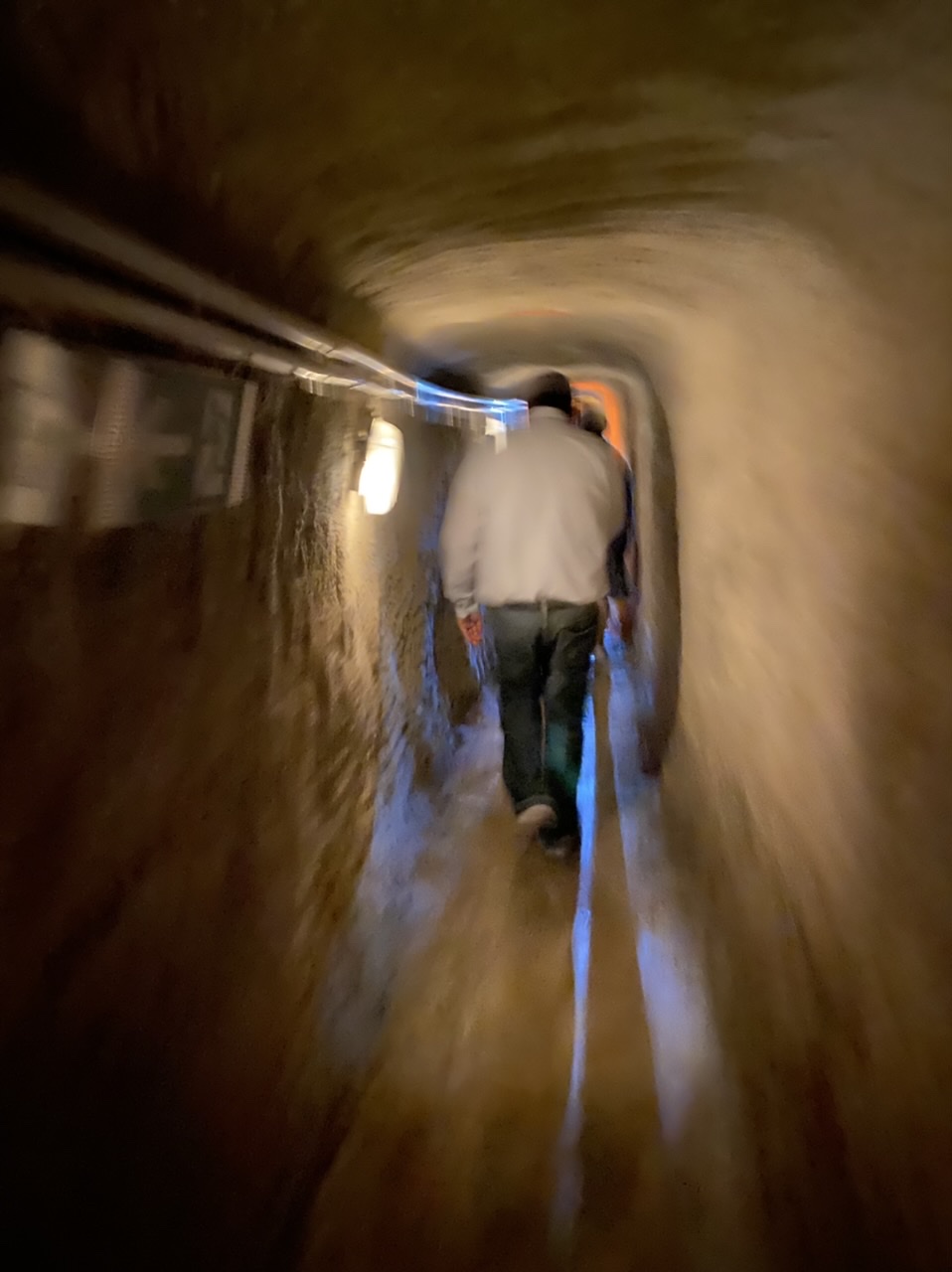
The tunnels were built from the 14th century onwards and were mainly used in the brewing of beer. At one point, Nürnberg had more than 40 breweries based in the city, and each had a rock cellar for fermenting and storing their beer. The tunnels were eventually joined up and they were used during World War 2 as bomb shelters for the locals and to store precious art as well. Some of the connecting tunnels are pretty small (I had to hunch not to hit my head) so definitely this isn’t a tour for someone with claustrophobia.
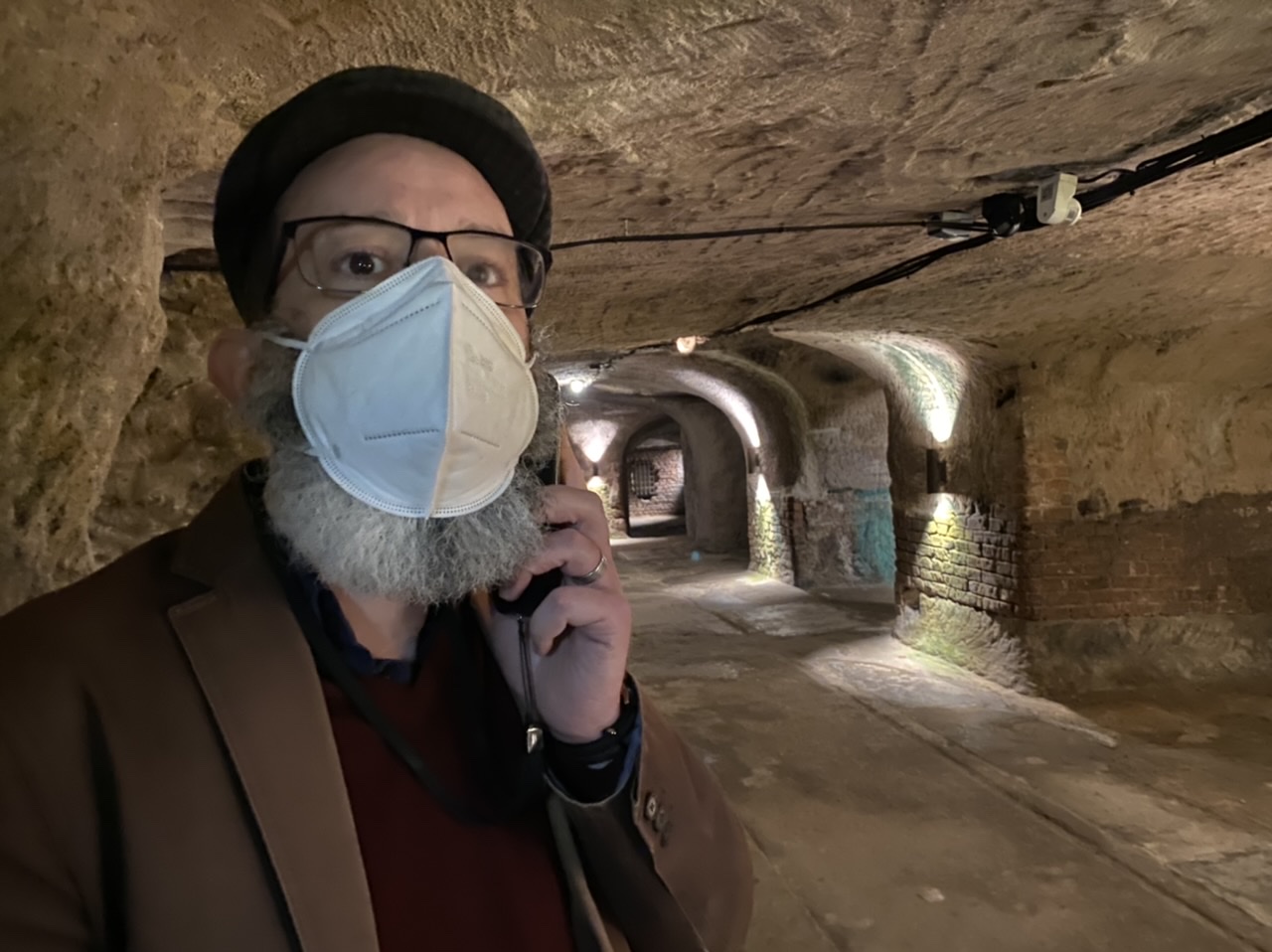
There were various stops along the way as we learned about the city, its history of beer making, and how the tunnels were used. We also learned about the Reinheitsgebot, the famous German beer purity law that was adopted across Bavaria in 1516.

There were also some informational exhibits along the way. Many showed medieval manuscripts with illustrations of monks brewing beer, often with a six-pointed star dangling above the pot. Our guide explained that it had nothing to do with Judaism, but instead was known as the Brewer’s Star meant to ward off fires and bad spirits.
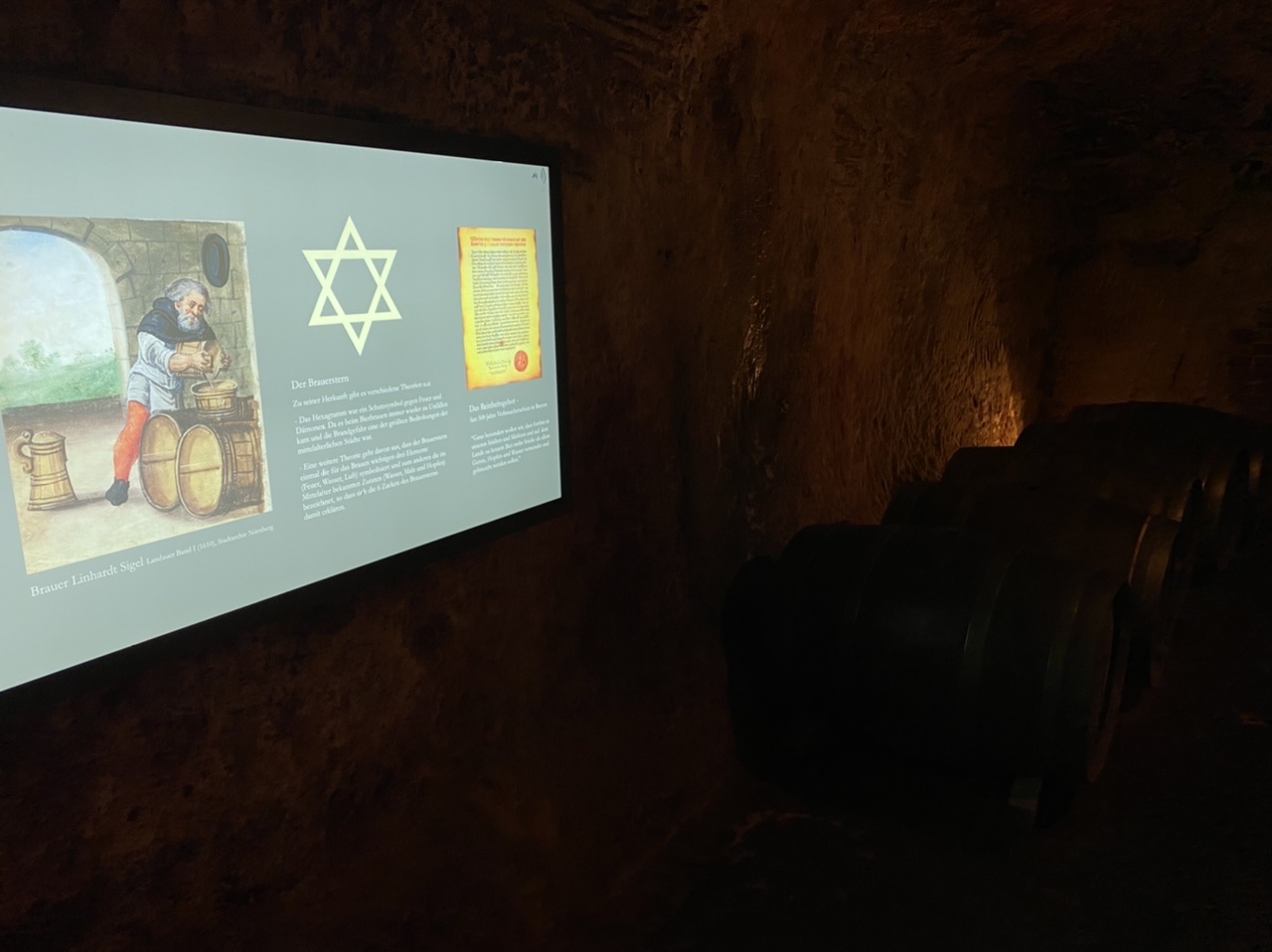
The cellars were dug very deep, up to 4 stories in places. However over the years some of them were altered or destroyed, and so changes have been made to conserve them. Our guide told us how in this vault, there are columns, beams, and support rods holding the walls and ceiling to ensure they don’t collapse.
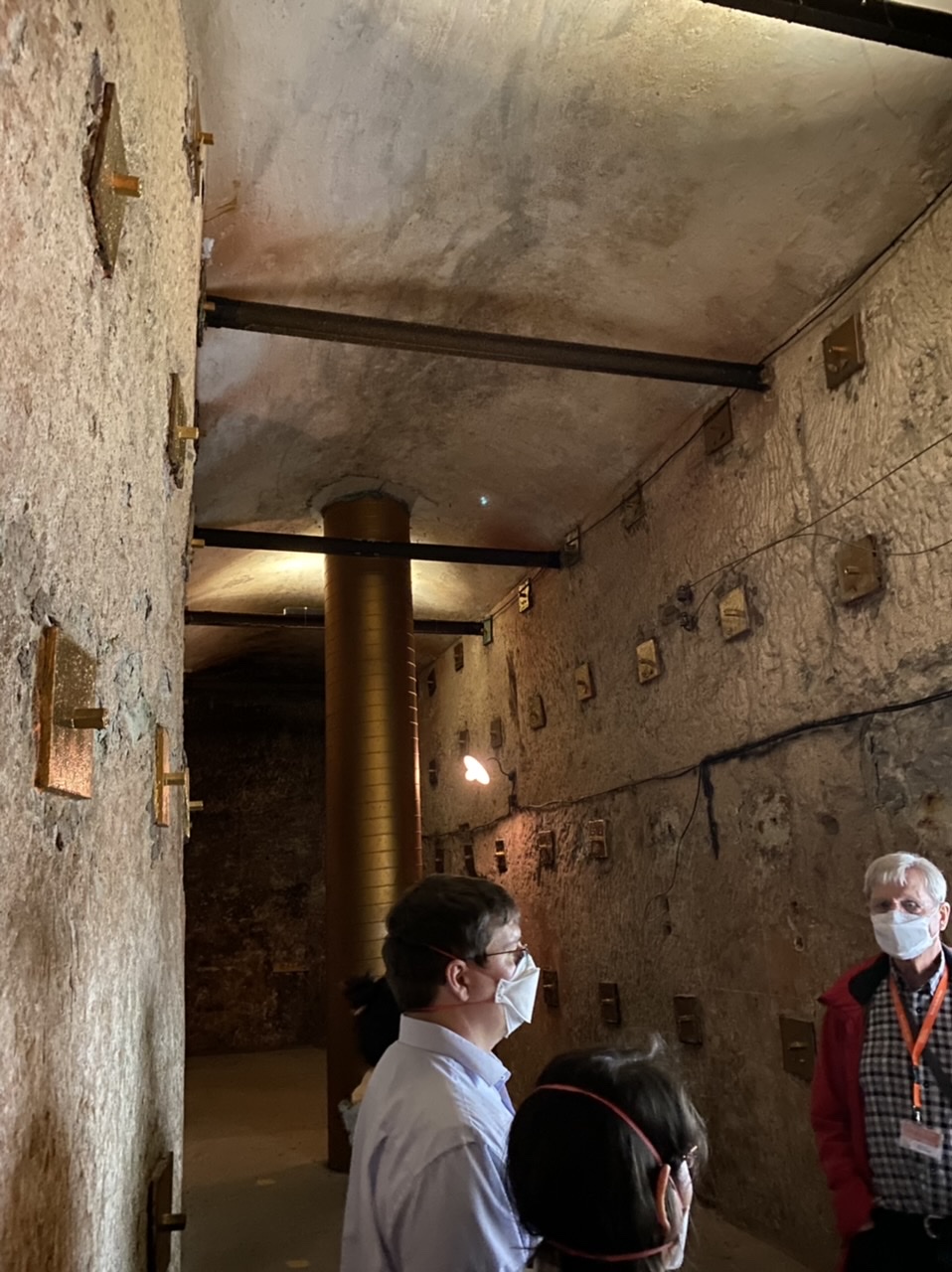
We also learned how ice was cut from lakes and transported to the cellars in the winter, where it would slowly melt over the summer and keep the tunnels cool enough for the beer fermentation. The sandstone also filtered groundwater, and we saw examples of primitive “pipes” made from bored-out logs that were used to transport the water.
Towards the end of the tour I jokingly asked the guide if there were any “Geister” (ghosts) down there. “Oh yes!” he answered. 😳
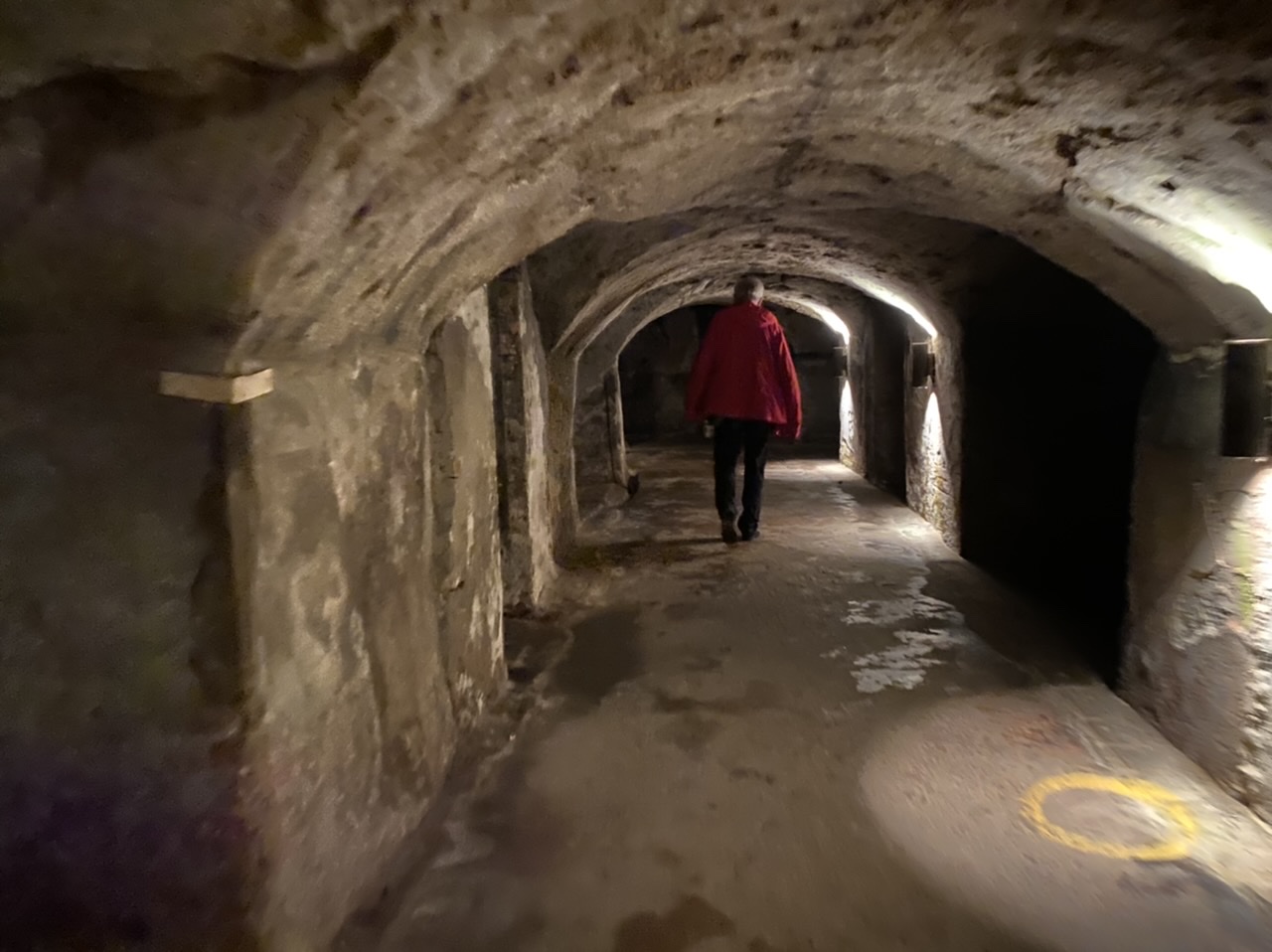
The tour ends back up at ground level where you are offered a sample of the famous local Rotbier (red beer) from the Altstadthof brewery.
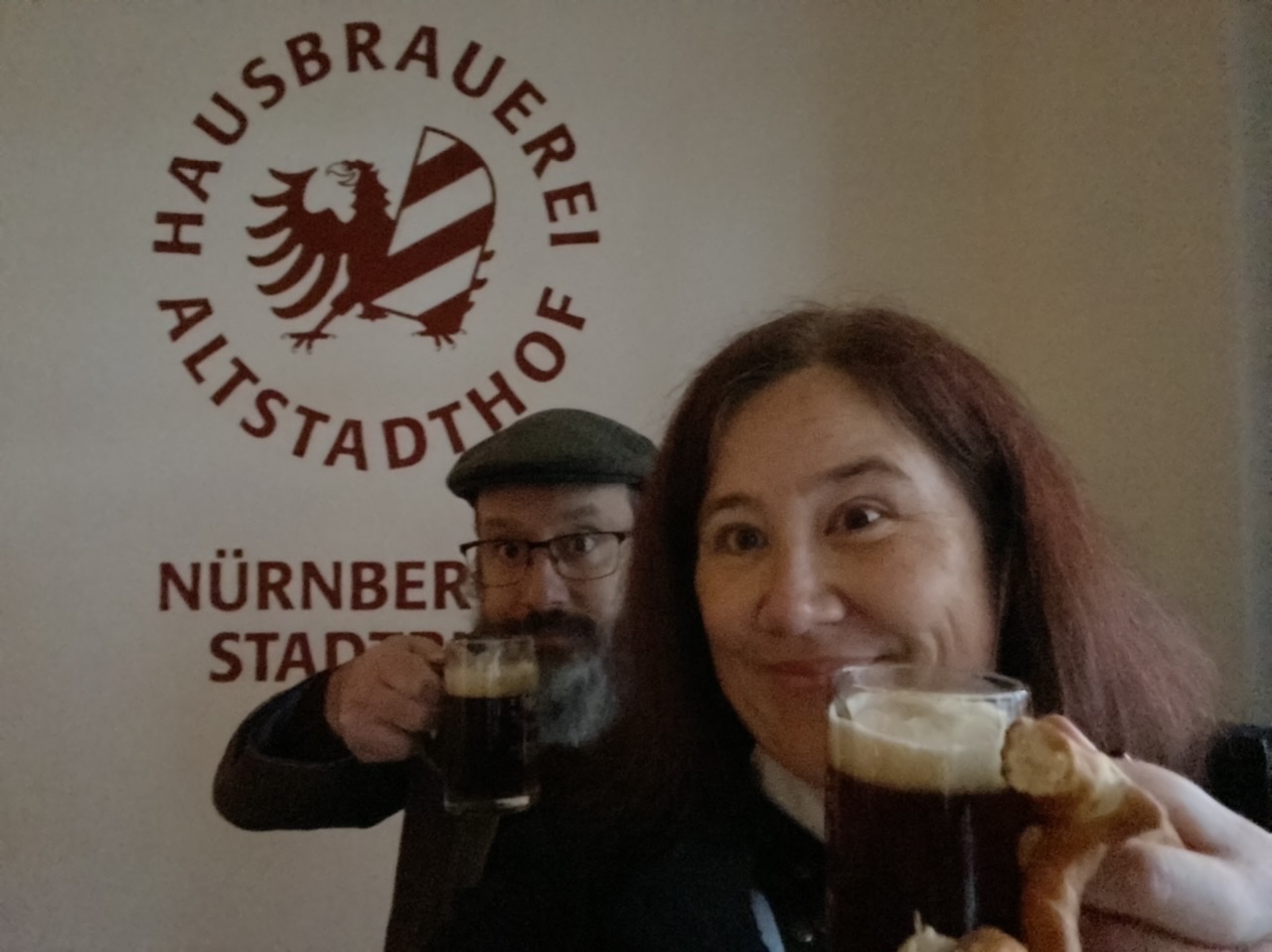
There’s also a distillery associated with the brewery, so we heard a bit about the process of making whisky and got to step inside one of the storerooms full of barrels. It smelled amazing. Needless to say, the Snook was in heaven.
After the tour, I had taken Frank’s advice and booked us in for dinner at the Brewery. We enjoyed some fine Franconian fare and sampled more of the beer…
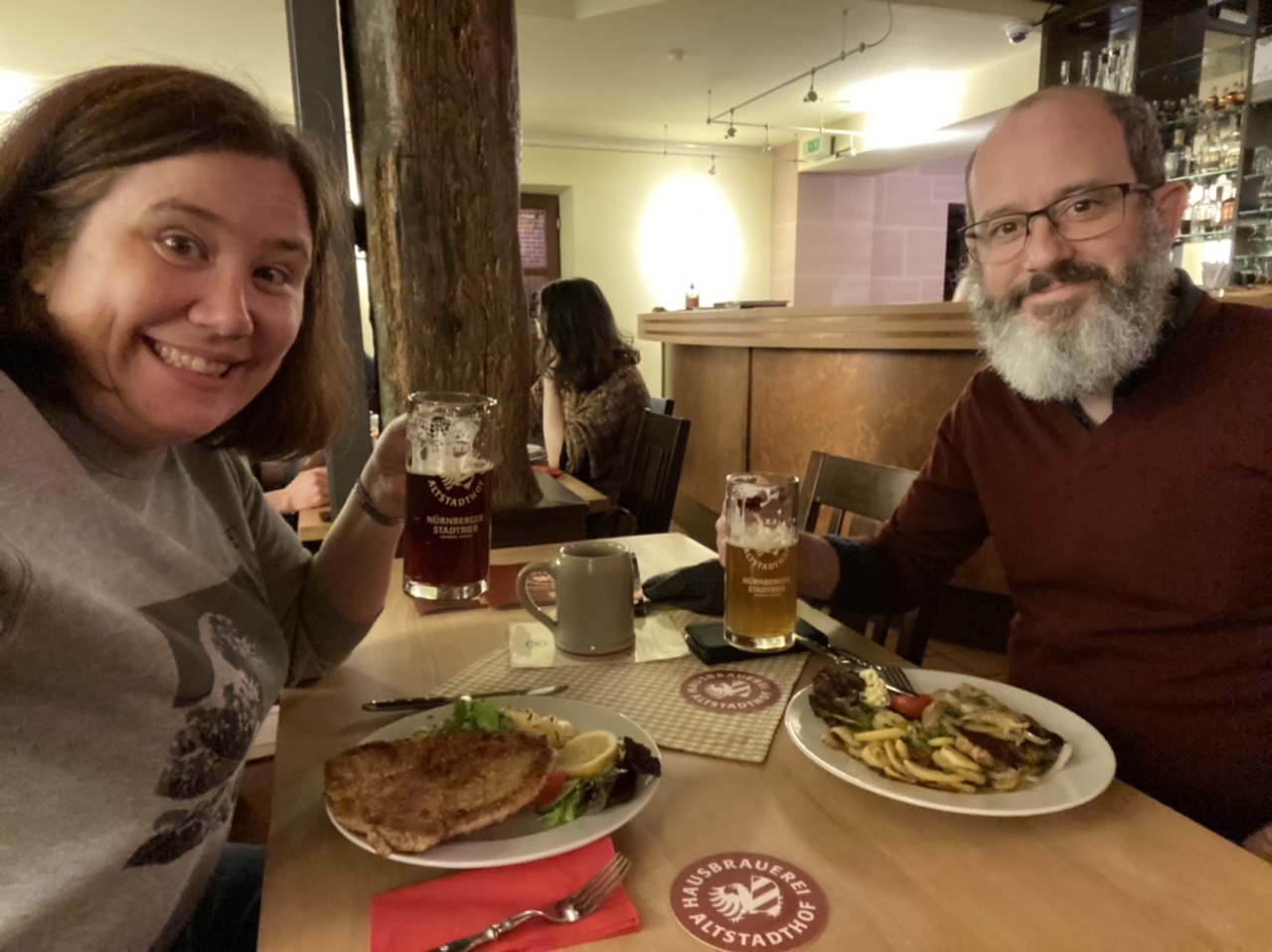
…and even a bit of their Bierbrand, which is distilled from beer itself. It’s similar to whisky but not exactly the same.
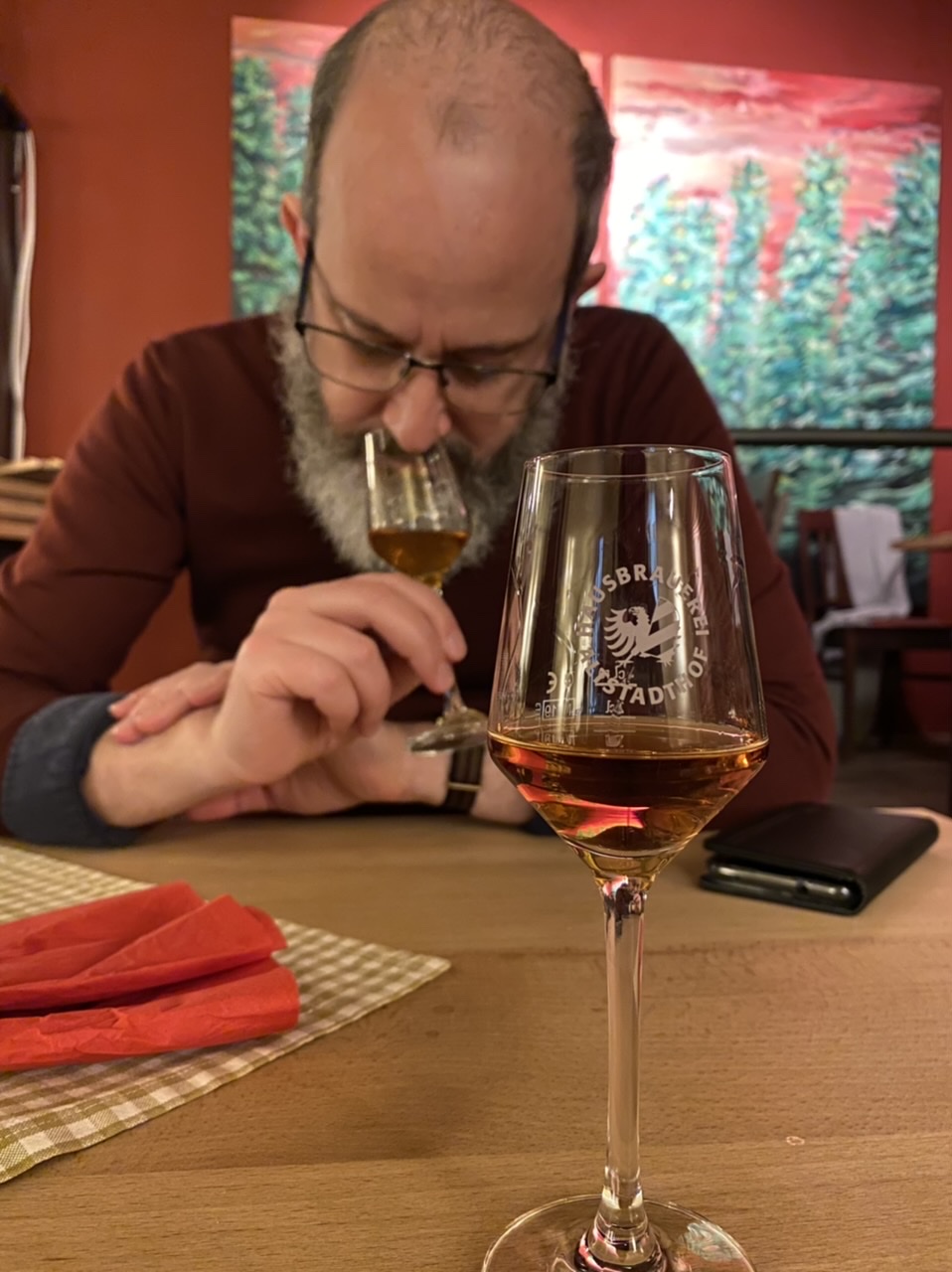
We decided to burn off some of those calories with a nighttime stroll around the city. We headed first to the castle with its dramatically lit walls and battlements.
From the castle we walked south down Burgstraße towards the Altes Rathaus (old city hall).
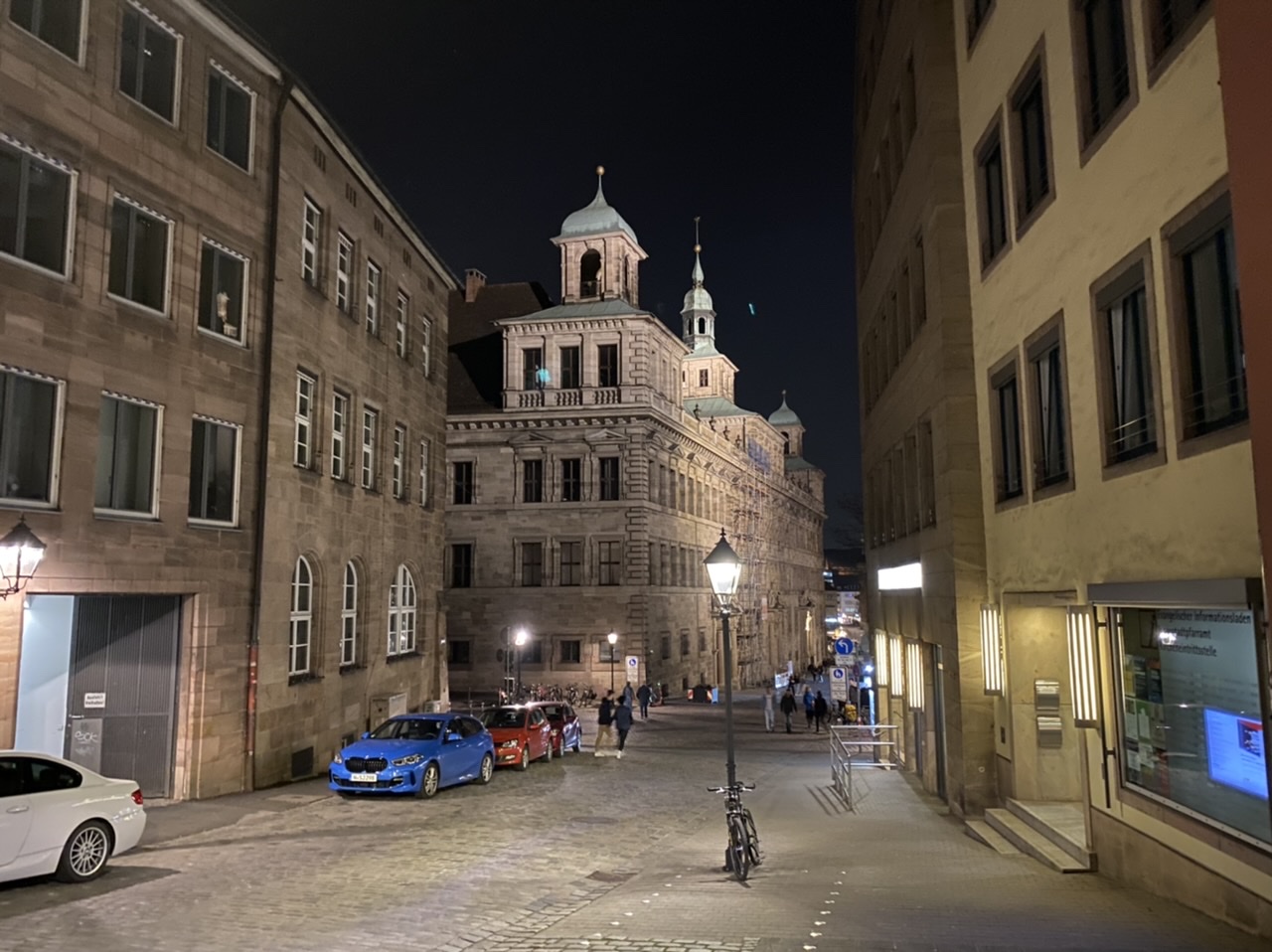
It stands directly behind St. Sebaldus Church.
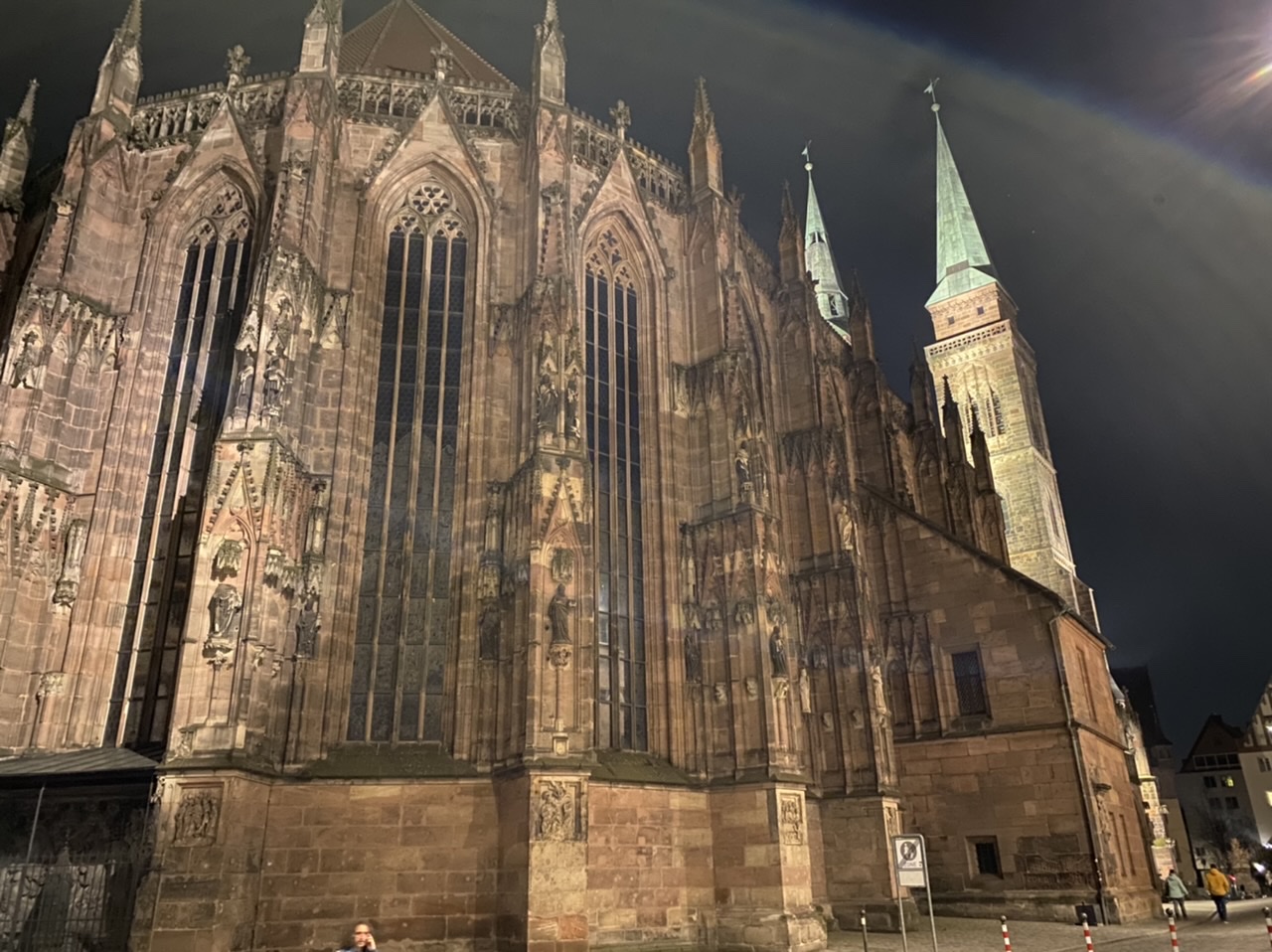
We continued on to the Hauptmarkt, the big public square where the world famous Christkindlesmarkt (Christmas market) is held each year. One of the attractions in the square is the Schöner Brunnen (beautiful fountain).
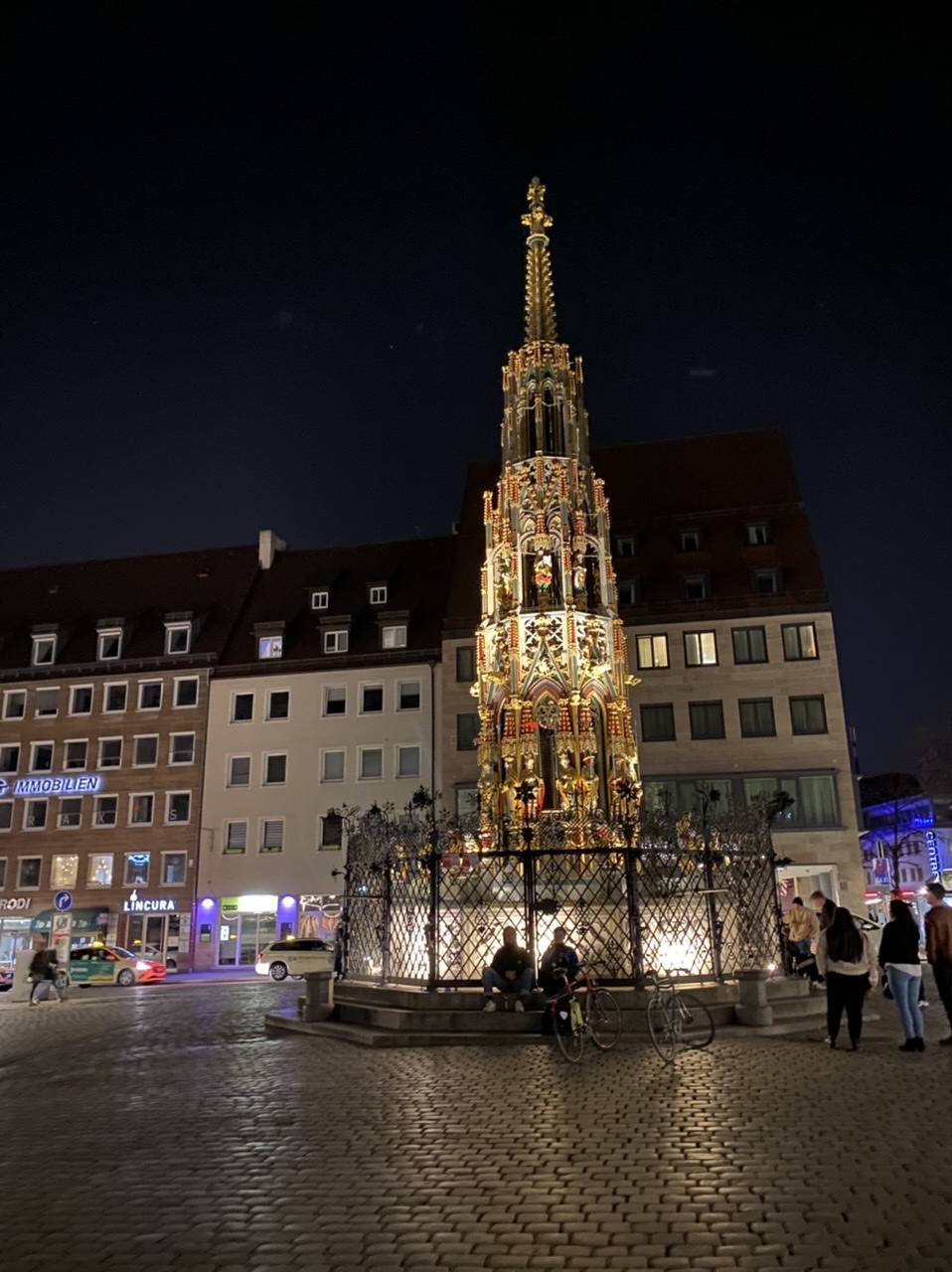
Nearby is the Frauenkirche (Church of Our Lady), which we would discover the next day has a very famous clock.
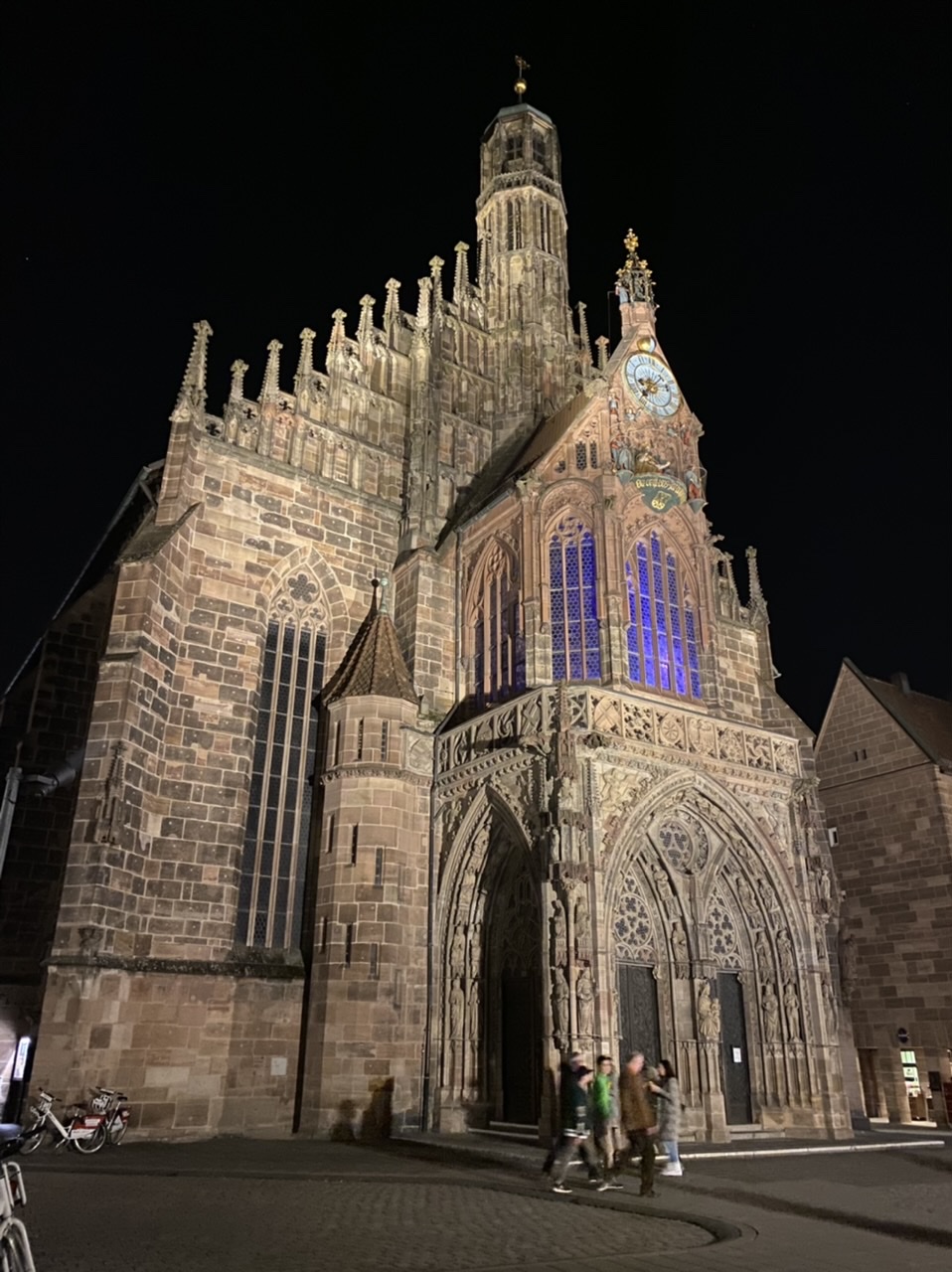
The river that flows through Nürnberg is the Pegnitz, and we crossed over the Museumsbrücke on our walk. From one side we could see the Fleischbrücke, a late Renaissance bridge that has stood for more than 400 years. On the other side we had a view of the Heilig-Geist-Spital built over the river. It was originally a hospital and now it’s an old folks’ home.
We headed back towards our hotel. Along the way we passed by St. Sebaldus Church again, this time from the front. St. Sebaldus is the patron saint of Nürnberg.
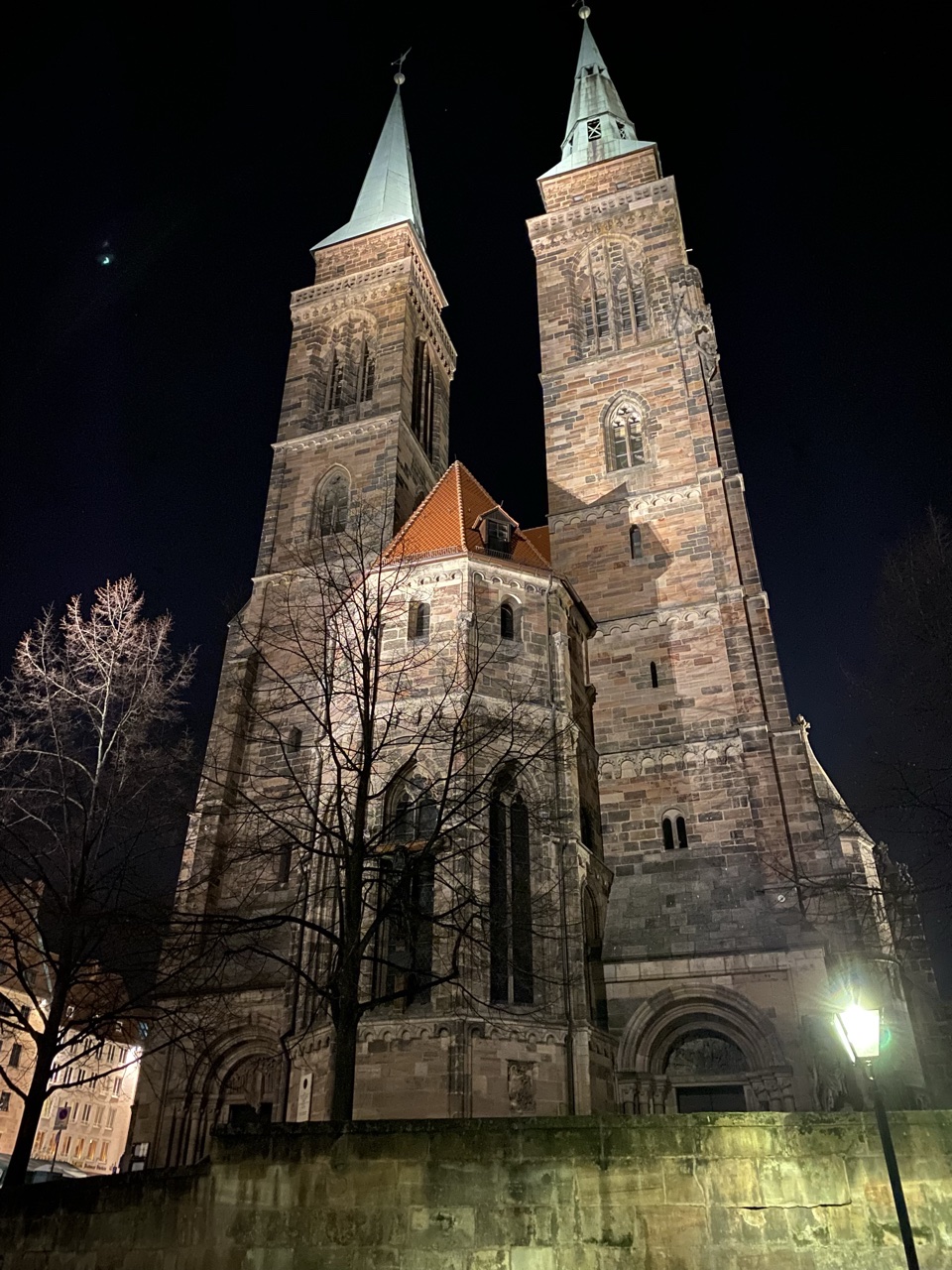
Still a bit nippy out of the sun, but Spring has sprung 🌱 and the flowers are blooming 🌸 and the beer is pouring. 🍻 2022 Biergarten count: 1!
